Blue is a captivating color that has a way of grabbing our attention like no other. From the deep indigo of the ocean to the soft pastel hues of a summer sky, blue has a timeless appeal.
And when it comes to the natural world, blue is one of the most striking colors that a bird can have. There are dozens of species of blue-colored birds found all over the world, each with their unique beauty and character.
These birds come in all shapes and sizes, ranging from the petite blue tit of Europe to the majestic blue macaw of South America.
In this article, we will delve deeper into some of the most fascinating blue-colored birds and explore what makes them so special.
1. Indian Peafowl
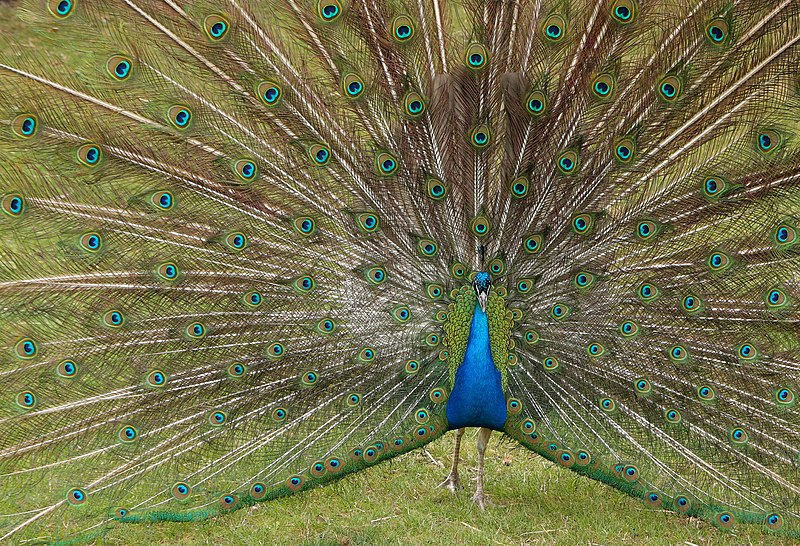
The Indian Peafowl, also known as the common peafowl or blue peafowl, is a species native to the Indian subcontinent. It has since been introduced to many other countries around the world.
Males are referred to as peacocks and females are called peahens, although both sexes can be colloquially referred to simply as “peacocks”.
These birds have an impressive display of sex-specific differences in coloration; males show off their iridescent feathers in shades of green and blues while female plumage tends towards more muted browns with red accents on their tail feathers.
The mating dance performed by male Peacocks serves not only for courtship but also acts as a form of territorial advertisement between rival males over available resources such as food sources.
This colorful bird lives up to its name with its beautiful displays that captivate viewers from all walks of life.
Scientific classification:
| Kingdom | Animalia |
| Phylum | Chordata |
| Class | Aves |
| Order | Galliformes |
| Family | Phasianidae |
| Genus | Pavo |
| Species | P. cristatus |
Also Featured In: Common Birds in India, Birds You’ll Find in Zoo
2. Thrush
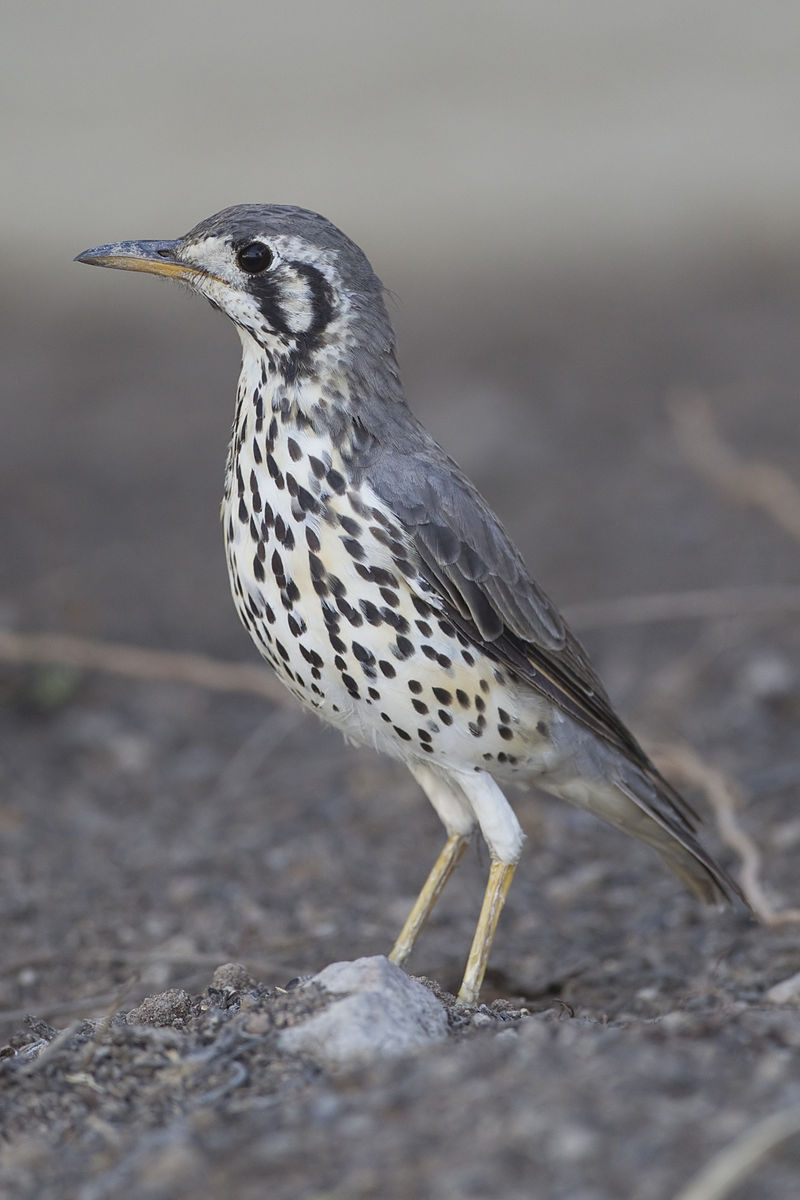
Thrushes are small to medium-sized birds belonging to the Turdidae family and found all over the world. They live on or near the ground and feed on insects, other invertebrates, and fruit.
Their feathers range from greyish browns to deep blues in color with spotted wings that help them blend into their natural habitats such as forests, woodlands, and shrubs.
Thrushes have distinctive songs that they sing during spring mating season; many species also perform complex flight displays for courtship rituals.
These birds may be solitary creatures but can often be seen foraging together in groups or pairs when searching for food sources like worms, snails, or berries.
A healthy thrush population is an indication of a balanced environment since they require clean water sources as well as plenty of vegetation cover – making them important indicators of ecosystem health worldwide.
Scientific classification:
| Kingdom | Animalia |
| Phylum | Chordata |
| Class | Aves |
| Order | Passeriformes |
| Suborder | Passeri |
| Family | Turdidae Rafinesque, 1815 |
Also Featured In: Most Common Songs Birds that Live around You, Most Common Romanian Birds
3. American Robin

The American robin is a migratory bird, belonging to the true thrush genus and Turdidae family.
It was named after its European counterpart due to the similar reddish-orange breast they both possess; however, they are not related closely.
This species can be seen through most of North America during winter months, as well as in parts of Mexico and Central America where it also breeds.
They have plump bodies with gray upperparts and white underparts that vary from yellow on their throats down to orange toward their bellies.
Robins feed on fruits such as berries or insects like worms which makes them an important part of ecosystems by helping disperse seeds naturally throughout these areas.
Scientific classification:
| Kingdom | Animalia |
| Phylum | Chordata |
| Class | Aves |
| Order | Passeriformes |
| Family | Turdidae |
| Genus | Turdus |
| Species | T. migratorius |
Also Featured In: Most Common United States Birds, Most Common Winter Birds
4. American Goldfinch
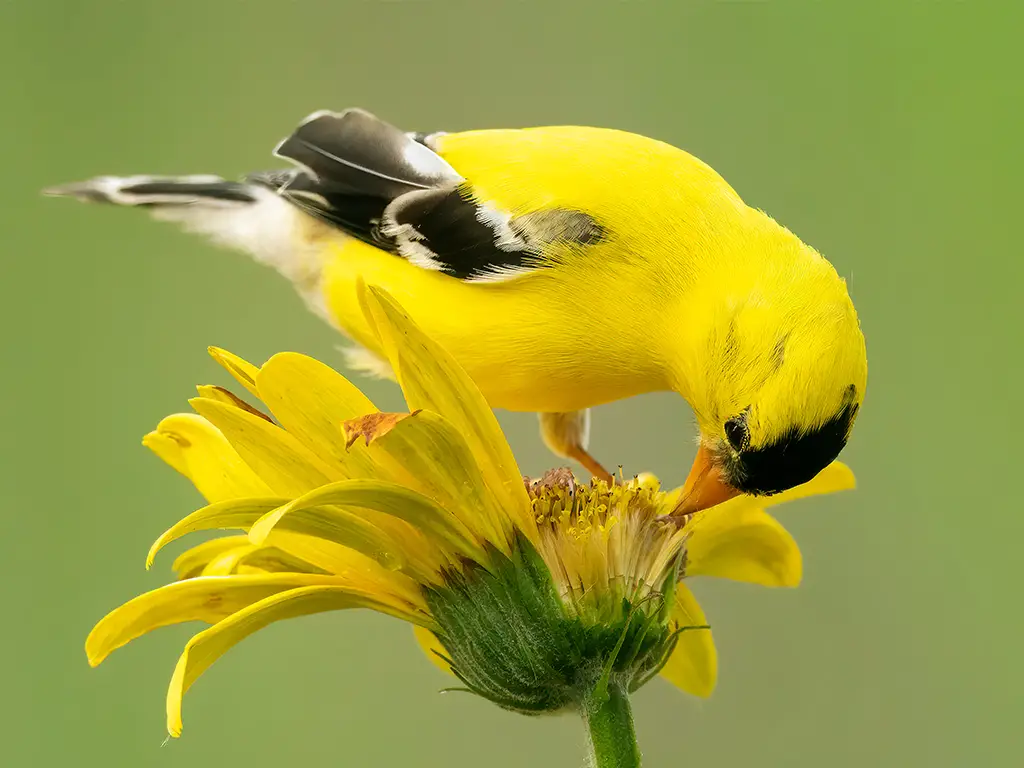
The American goldfinch is a small North American bird in the finch family. Males are vibrant yellow with black wings and tails, while females are duller in coloration.
It migrates from mid-Alberta to North Carolina during the breeding season, south of Canada–United States border to Mexico for its wintering grounds.
The only finch that undergoes complete molt every year, displays sexual dichromatism where males have brighter colors than their female counterparts.
They feed mainly on seeds but also eat insects such as aphids and caterpillars when raising young; they often occur near thistles or other plants that produce viable seed heads.
Their call consists of an array of chirps and trills making them quite conspicuous.
Scientific classification:
| Kingdom | Animalia |
| Phylum | Chordata |
| Class | Aves |
| Order | Passeriformes |
| Family | Fringillidae |
| Subfamily | Carduelinae |
| Genus | Spinus |
| Species | S. tristis |
Also Featured In: Birds Live in Arkansas, New Hampshire Birds You Should Know
5. Songbirds
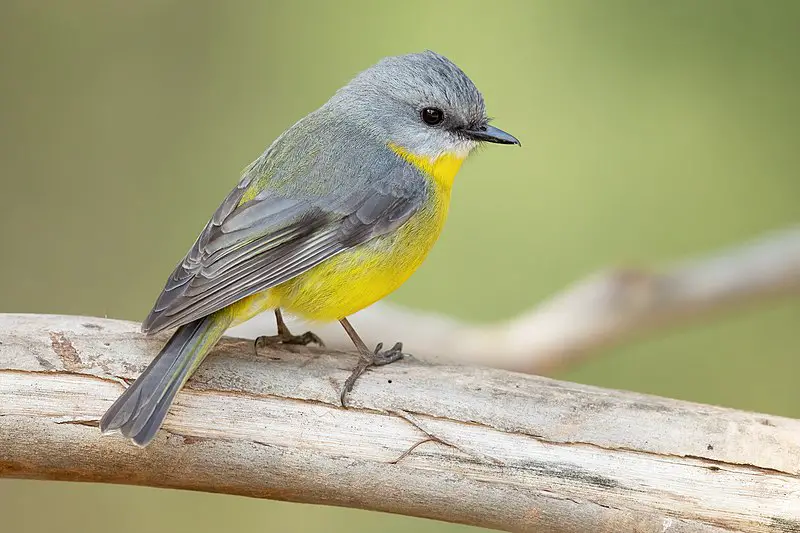
Songbirds are a special suborder of perching birds found all over the world. These beautiful creatures have intricate vocal organs that allow them to produce elaborate bird songs, making them stand out from other species.
With around 5,000 different types of songbirds in existence, they come in various sizes and colors with complex feathers adding to their beauty.
Songbirds play an important role in ecosystems as they help disperse seeds by eating fruit and insects which act as agents for pollination.
Their presence also serves to attract more biodiversity into areas where these delicate animals live, creating vibrant habitats full of life.
Scientific classification:
| Kingdom | Animalia |
| Phylum | Chordata |
| Class | Aves |
| Order | Passeriformes |
| Clade | Eupasseres |
| Suborder | Passeri Linnaeus, 1758 |
Also Featured In: Famous Paintings Birds, Common Birds in the Cities
6. Bluebirds
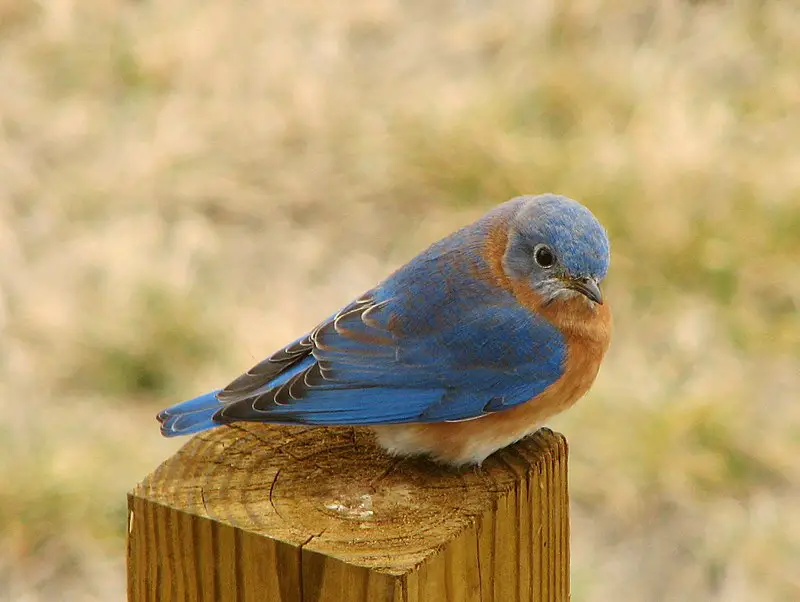
Bluebirds are a North American species of small to medium-sized birds belonging to the thrush family. They have stunning blue and rose beige plumage, with males having brighter colors than females.
These beautiful birds mainly feed on insects, but they can also eat some fruits or seeds from time to time. Bluebirds reside in open fields, meadows, and backyards across much of North America.
Their cheerful songs bring joy as they fly through their habitats looking for food during the day before returning home at nightfall.
The sight of these beautiful creatures is often associated with happiness and hope – making them beloved by many people.
Scientific classification:
| Kingdom | Animalia |
| Phylum | Chordata |
| Class | Aves |
| Order | Passeriformes |
| Family | Turdidae |
| Subfamily | Myadestinae |
| Genus | Sialia Swainson, 1827 |
Also Featured In: Birds of Symbolism, Spiritual Birds
7. Mountain Bluebird
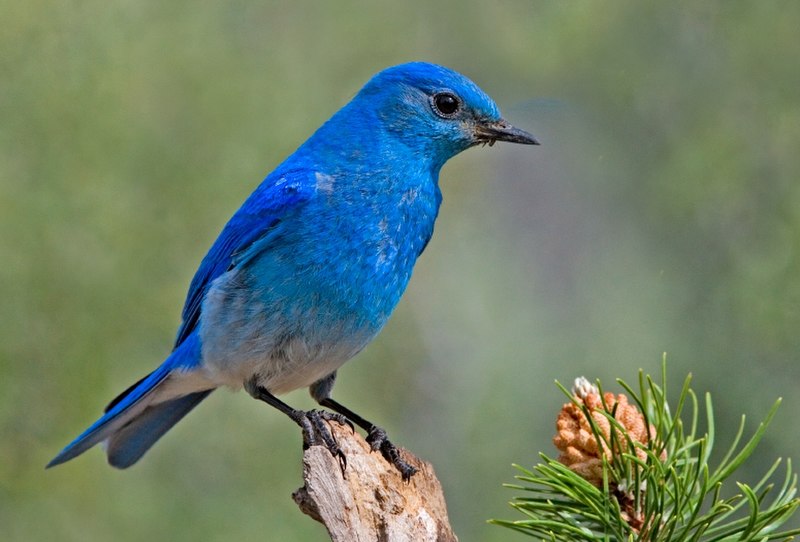
The Mountain Bluebird is a beautiful sight to behold. It has bright turquoise-blue wings and tail, with a light underbelly, grey crown and breast, black eyes, and thin bills.
During the fall season, its plumage changes slightly – females have duller blue wings and tails, as well as a grey throat and back.
As they migrate across western North America during springtime these birds can be found in mountainous districts where they feed on insects such as grasshoppers or crickets collected from meadows or fields of grain.
They also enjoy eating berries when available. Through their stunning colors, this species adds vibrancy to any landscape it traverses through – truly an incredible creature of nature.
Scientific classification:
| Kingdom | Animalia |
| Phylum | Chordata |
| Class | Aves |
| Order | Passeriformes |
| Family | Turdidae |
| Genus | Sialia |
| Species | S. currucoides |
Also Featured In: Birds Commonly Found in Northern California, Birds that Found in the Yellowstone
8. Eastern Bluebird
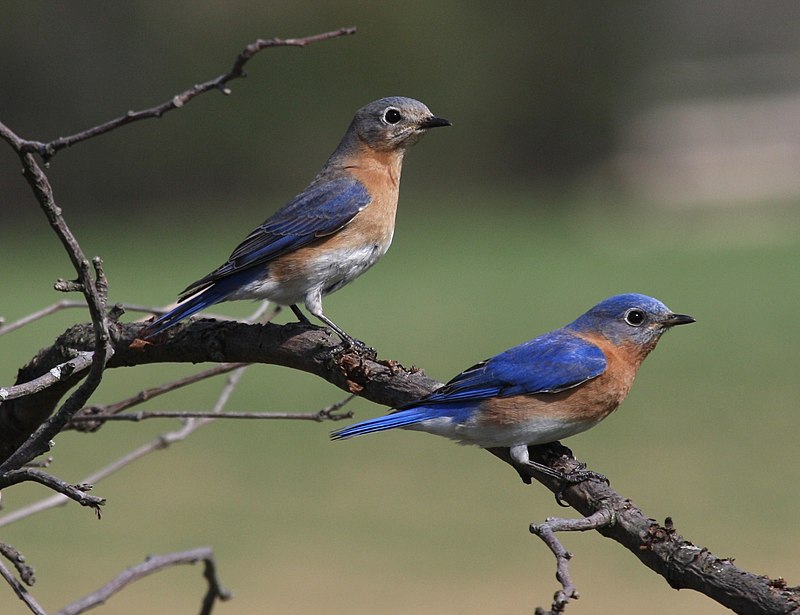
The Eastern bluebird is a small migratory thrush that can be found in open woodlands, farms, and orchards across North America.
The male has bright-blue breeding plumage which makes it easily recognizable by birders.
It produces melodious songs such as jeew, chir-wi, and chiti WEEW wewidoo.
This popular species was declared the state bird of Missouri back in 1927 due to its beauty and charm.
In addition to being beautiful, these birds are also beneficial for farmers because they eat insects like grasshoppers and beetles which damage crops.
They nest in cavities so providing nesting boxes helps them thrive even more.
With their vibrant colors, sweet melodies, and helpful nature it’s easy to see why the Eastern Bluebird is beloved worldwide.
Scientific classification:
| Kingdom | Animalia |
| Phylum | Chordata |
| Class | Aves |
| Order | Passeriformes |
| Family | Turdidae |
| Genus | Sialia |
| Species | S. sialis |
Also Featured In: Birds that Migrate through Illinois in the Spring, Birds that Live in Mississippi
9. Blue Jay

The Blue Jay is a beautiful bird that resides in the eastern and central United States, as well as Newfoundland Canada.
They have an unmistakable blue colored plumage with white markings on their heads and wings.
These birds are highly adaptable to different habitats ranging from deciduous forests to urban areas.
As part of the Corvidae family, they are known for being intelligent problem solvers who will often use tools or mimic vocalizations of other species like hawks when defending their territories.
Their diet consists mostly of insects, seeds, and nuts but can also include small vertebrates such as frogs or lizards if food resources become scarce.
Overall these birds provide much-needed color to our environment while playing important roles in maintaining healthy ecosystems through pollination services and seed dispersal activities.
Scientific classification:
| Kingdom | Animalia |
| Phylum | Chordata |
| Class | Aves |
| Order | Passeriformes |
| Family | Corvidae |
| Genus | Cyanocitta |
| Species | C. cristata |
Also Featured In: Most Common Nature Birds, Autumn Birds You Should Know
10. New World Warblers

New World warblers are an incredibly diverse family of small birds found only in the Americas. They range in size from tiny hummingbirds to large thrushes and come in a variety of vibrant colors.
All have thin bills made for eating insects which form their main diet. Most species live predominantly arboreal lives, meaning they spend most of their time among trees or bushes searching for food.
However, some members such as ovenbirds and waterthrushes prefer more terrestrial habitats like forest floors where they can scavenge for bugs on the ground instead.
Warblers provide a great source of entertainment with their beautiful songs often filling up woodlands during mornings and evenings throughout springtime.
Scientific classification:
| Kingdom | Animalia |
| Phylum | Chordata |
| Class | Aves |
| Order | Passeriformes |
| Superfamily | Emberizoidea |
| Family | Parulidae Wetmore et al., 1947 |
Also Featured In: Common Denmark Birds, British Columbian Birds
11. Common Starling

The Common Starling is a medium-sized passerine bird that belongs to the Starling family. It has glossy black plumage with a metallic sheen, and at certain times of year, it can be speckled with white.
The bill and legs are typically pink or black depending on the season, while its length measures about 8 inches long.
Its diet consists mainly of insects but also includes small fruits and seeds as well as some human food waste.
They live in large flocks which protects predators, although they can become quite aggressive when defending their nesting sites during breeding seasons.
Overall, this species is highly adaptable and widely distributed across many parts of Europe making them one of the most successful birds in the region today.
Scientific classification:
| Kingdom | Animalia |
| Phylum | Chordata |
| Class | Aves |
| Order | Passeriformes |
| Family | Sturnidae |
| Genus | Sturnus |
| Species | S. vulgaris |
Also Featured In: Ukrainian Birds You Should Know, European Birds
12. White-Breasted Nuthatch

The White-breasted Nuthatch is a medium-sized bird belonging to the nuthatch family Sittidae. It measures around 15.5 cm in length and its color varies throughout its range.
Males have a light blue-grey upperpart, with a black crown and nape whereas females have a dark grey crown instead of a black one.
The underparts are whitish, with a reddish tinge on the sides and flanks while the bill is short and stout with a pale base near the eyes which can be yellow or white depending upon geographic location.
This species feeds mainly on insects but will also eat seeds, nuts, and berries when available.
They prefer open woodlands where they often climb trees searching for food along trunks as well as branches underneath bark crevices creating their nest there too.
Scientific classification:
| Kingdom | Animalia |
| Phylum | Chordata |
| Class | Aves |
| Order | Passeriformes |
| Family | Sittidae |
| Genus | Sitta |
| Species | S. carolinensis |
Also Featured In: Common Birds in Alberta, Birds in Iowa Spring
13. Belted Kingfisher
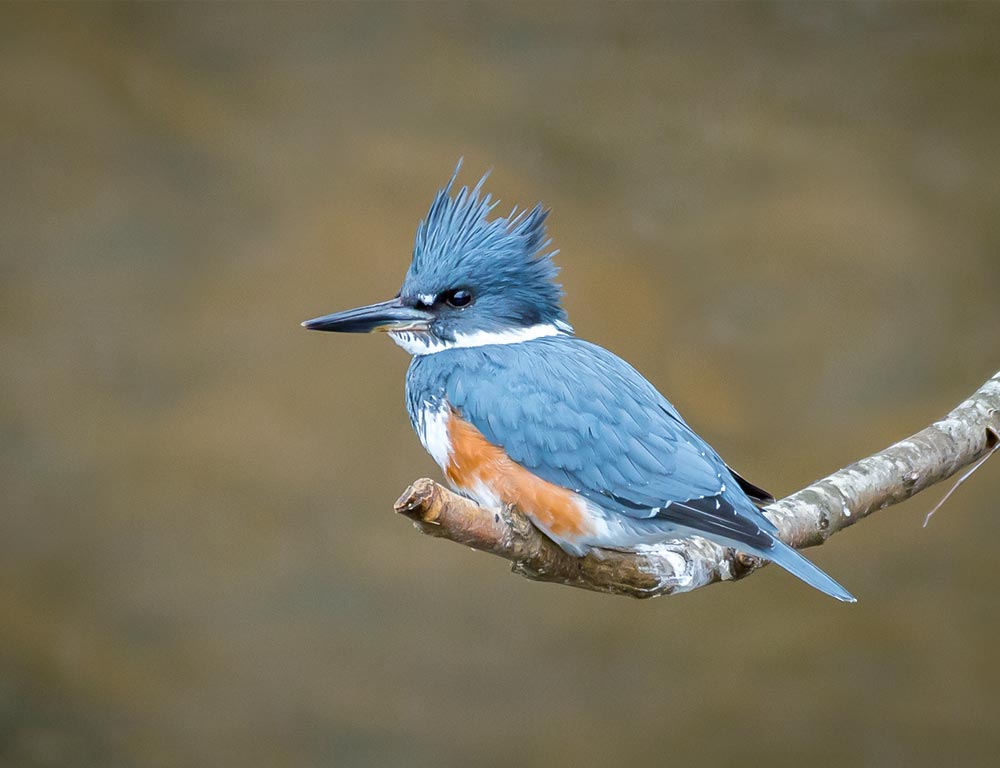
The belted kingfisher is a large, eye-catching bird native to North America. It belongs to the family Alcedinidae and has been divided into three subfamilies by recent research.
The species was first described in 1758 by Carl Linnaeus in his Systema Naturae.
This water Kingfisher stands out for its size as well as its striking plumage; males are bright blue on top with white below and females have rusty brown backs and wings with a thick black breast band across their chest.
They also possess an impressive call that can be heard from quite far away.
Belted kingfishers feed mainly on small fish but will sometimes also eat crustaceans, insects, or even amphibians if they come across them while hunting around rivers or streams.
All in all, this is truly one remarkable bird that deserves our admiration.
Scientific classification:
| Kingdom | Animalia |
| Phylum | Chordata |
| Class | Aves |
| Order | Coraciiformes |
| Family | Alcedinidae |
| Subfamily | Cerylinae |
| Genus | Megaceryle |
| Species | M. alcyon |
Also Featured In: Most Popular Bird Species in North America, Long Island Birds You Should Know
14. Barn Swallow
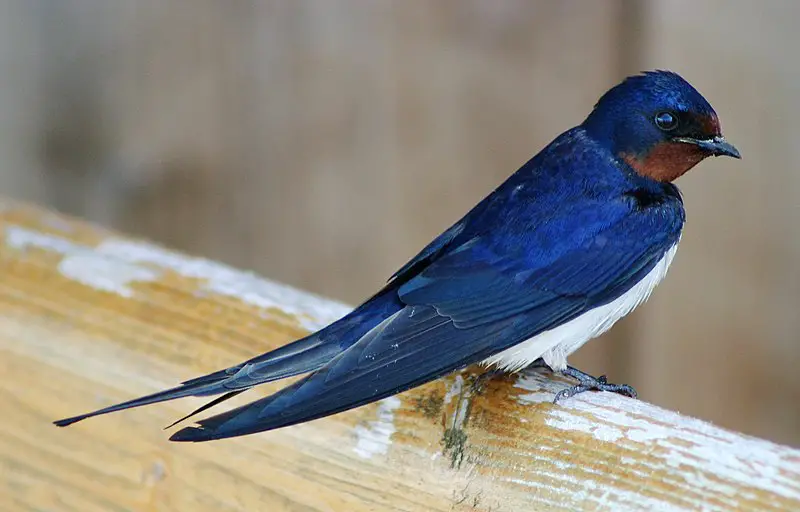
The Barn Swallow is a beautiful passerine bird with blue upperparts and a long, deeply forked tail. Found in Europe, Asia, Africa and the Americas.
It has an astonishingly large natural distribution spanning 251 million square kilometers globally; likely making it one of the world’s most widespread species.
This swallow typically nests near human habitation as well as other open areas such as fields or grasslands which provide them with suitable invertebrate prey to feed on.
They are insectivorous birds that often fly together in flocks looking for food over rivers or marshes usually just above tree-top level.
The barn swallow can also be identified by its strong flight consisting of swift continuous wing beats interspersed with glides during which they hold their wings slightly raised at the shoulders giving them distinct V-shaped silhouettes in the sky.
Scientific classification:
| Kingdom | Animalia |
| Phylum | Chordata |
| Class | Aves |
| Order | Passeriformes |
| Family | Hirundinidae |
| Genus | Hirundo |
| Species | H. rustica |
Also Featured In: Birds that Live in Croatia, Common Estonian Birds
15. Common Grackle

The Common Grackle is a large icterid bird commonly found in North America. It has an iridescent head and pale yellow eyes, which are framed by its long dark bill and long tail.
Males typically have more vivid colors on their heads than females do. These birds can be seen across much of the continent, in fields, forests, wetlands – even urban areas.
They form huge flocks to search for food such as grains or insects that they catch with their bills.
The grackles may also scavenge from human sources like garbage dumps or picnic tables if available. With its colorful plumage and distinct call it’s easy to spot this species amongst other birds.
Scientific classification:
| Kingdom | Animalia |
| Phylum | Chordata |
| Class | Aves |
| Order | Passeriformes |
| Family | Icteridae |
| Genus | Quiscalus |
| Species | Q. quiscula |
Also Featured In: Common Central Park Birds, Common Birds in Saskatchewan
16. Finches
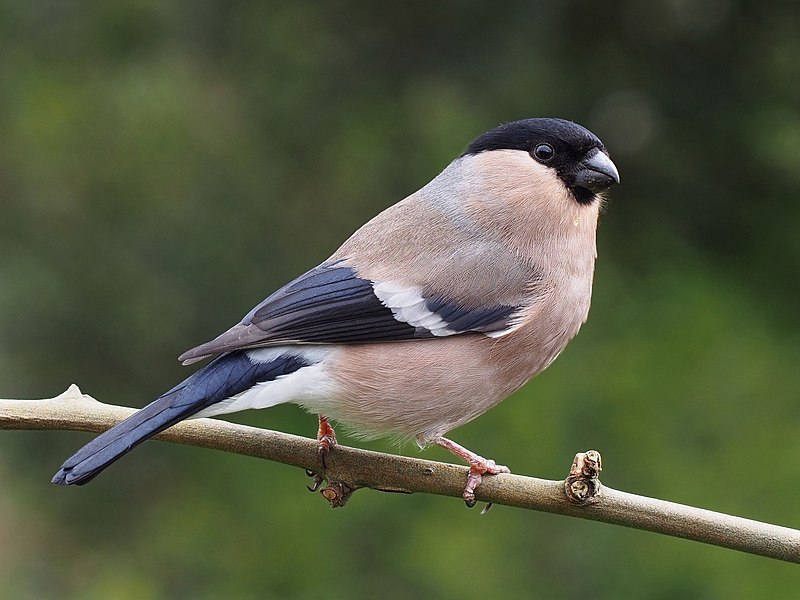
Finches are a diverse group of passerine birds found around the world, excluding Australia and polar regions. They vary in size from small to medium-sized, with stout conical bills adapted for eating seeds and nuts.
Many species have brightly coloured plumage; this helps them stand out against their natural habitats which can range from deserts to forests.
Finches occupy these areas all year round without migrating elsewhere – making them particularly well suited for local environments.
As part of the Fringillidae family, they possess unique characteristics that make them popular amongst birdwatchers everywhere.
Scientific classification:
| Kingdom | Animalia |
| Phylum | Chordata |
| Class | Aves |
| Order | Passeriformes |
| Superfamily | Passeroidea |
| Family | Fringillidae Leach, 1820 |
Also Featured In: Native Pakistani Birds, Birds for Your Home Garden
17. Tanagers
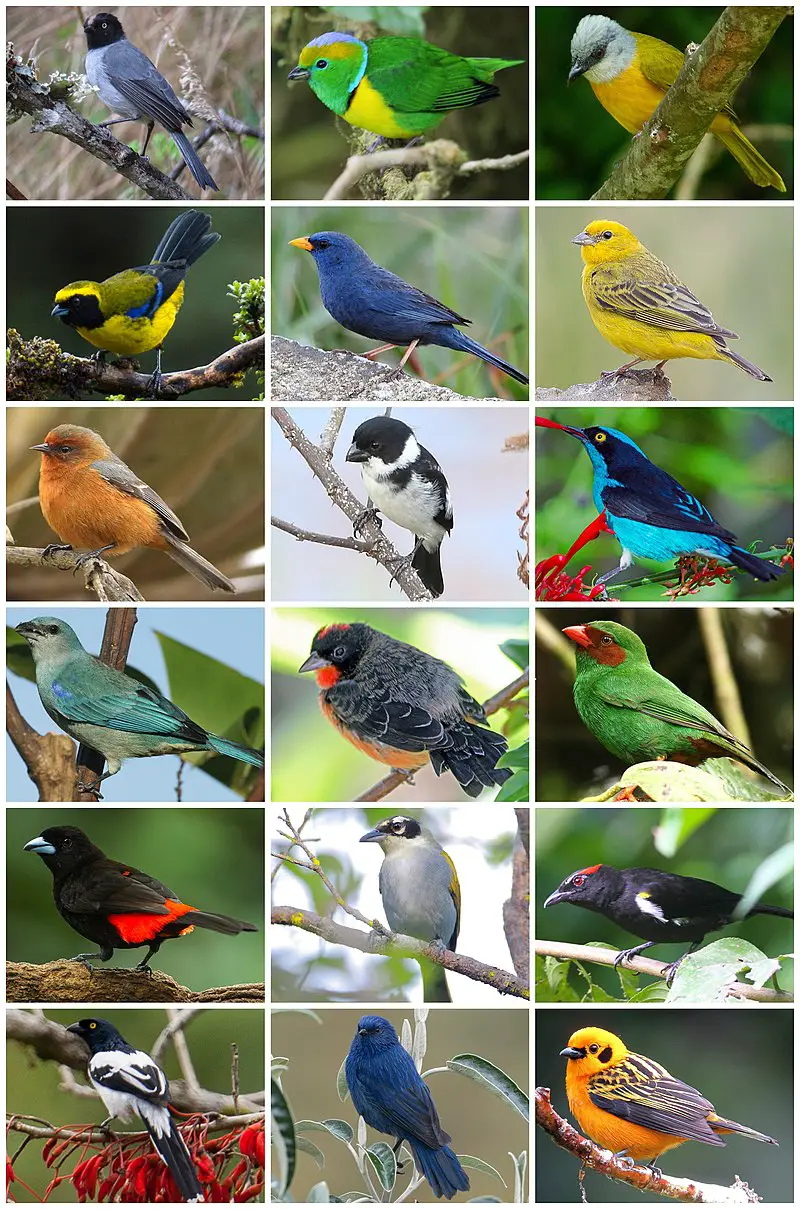
The Tanagers are a beautiful and diverse family of birds native to the Neotropical region. They boast an impressive array of colors, including blues, greens, yellows and reds.
The most common type is the fruit-eating tanager which can be found in tropical forests across Latin America. With nearly 240 species worldwide, they represent almost 4% of all avian species.
These vibrant birds have adapted well to their environment due to their strong bills used for cracking open hard fruits as well as sharp claws for gripping branches while feeding or perching.
As with many other bird families, there is natural variation among populations making each one unique in its own way; something that makes them even more special.
Scientific classification:
| Kingdom | Animalia |
| Phylum | Chordata |
| Class | Aves |
| Order | Passeriformes |
| Superfamily | Emberizoidea |
| Family | Thraupidae Cabanis, 1847 |
Also Featured In: Beautiful Brazilian Birds, Most Common Lake Birds
18. Hyacinth Macaw
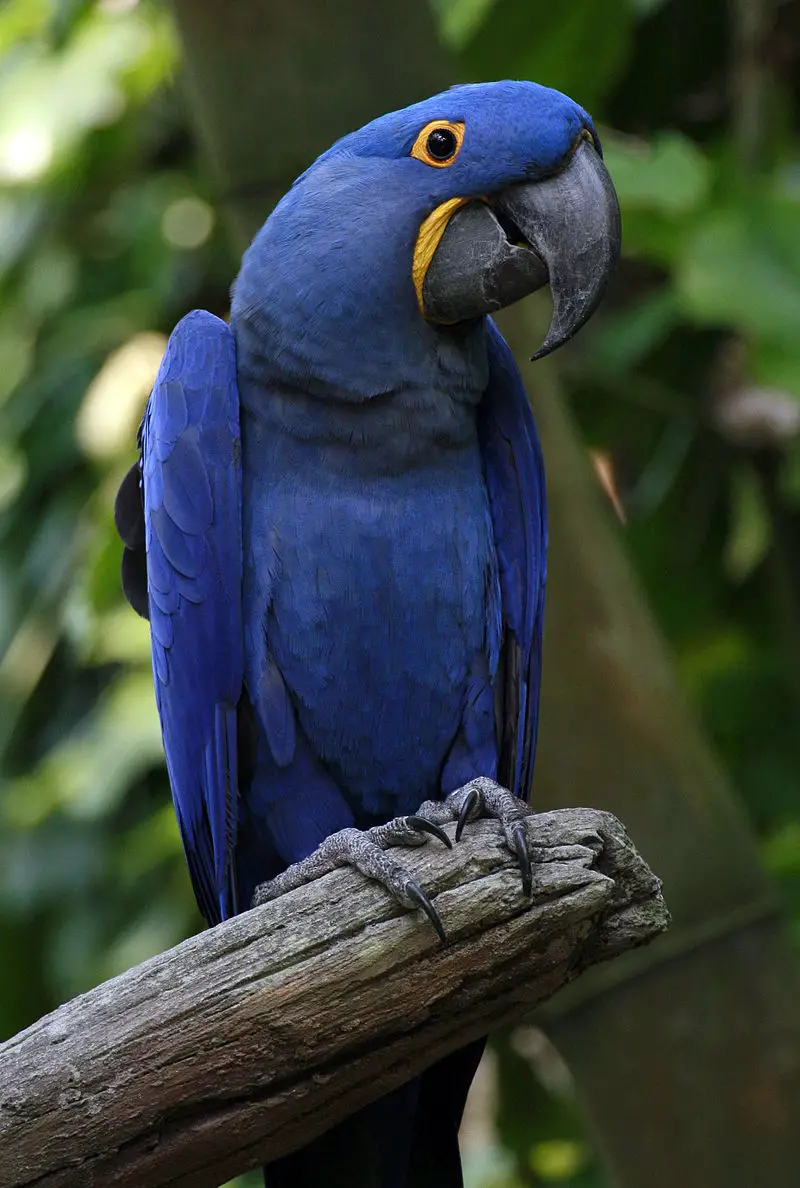
The Hyacinth Macaw is an extraordinary bird, known for its impressive size and vibrant coloration.
It has a length of around one meter, making it the longest parrot species in existence as well as the largest flying parrot species; even larger than 3.5 kg flightless Kākāpō from New Zealand.
Its striking blue plumage with yellow at its wingtips gives this majestic bird an eye-catching appearance that’s sure to turn heads wherever it goes.
Native to central and eastern South America, these birds are highly intelligent creatures who form strong bonds with their owners when kept in captivity.
They make great companions if given proper care and attention which includes providing them with plenty of space for exercise and enrichment activities such as playtime out of the cage on occasion or teaching them tricks using positive reinforcement methods like verbal praise or food rewards.
Scientific classification:
| Kingdom | Animalia |
| Phylum | Chordata |
| Class | Aves |
| Order | Psittaciformes |
| Family | Psittacidae |
| Genus | Anodorhynchus |
| Species | A. hyacinthinus |
Also Featured In: Birds That Live in the Jungle, Rainforest Birds You Should Know
19. Herons
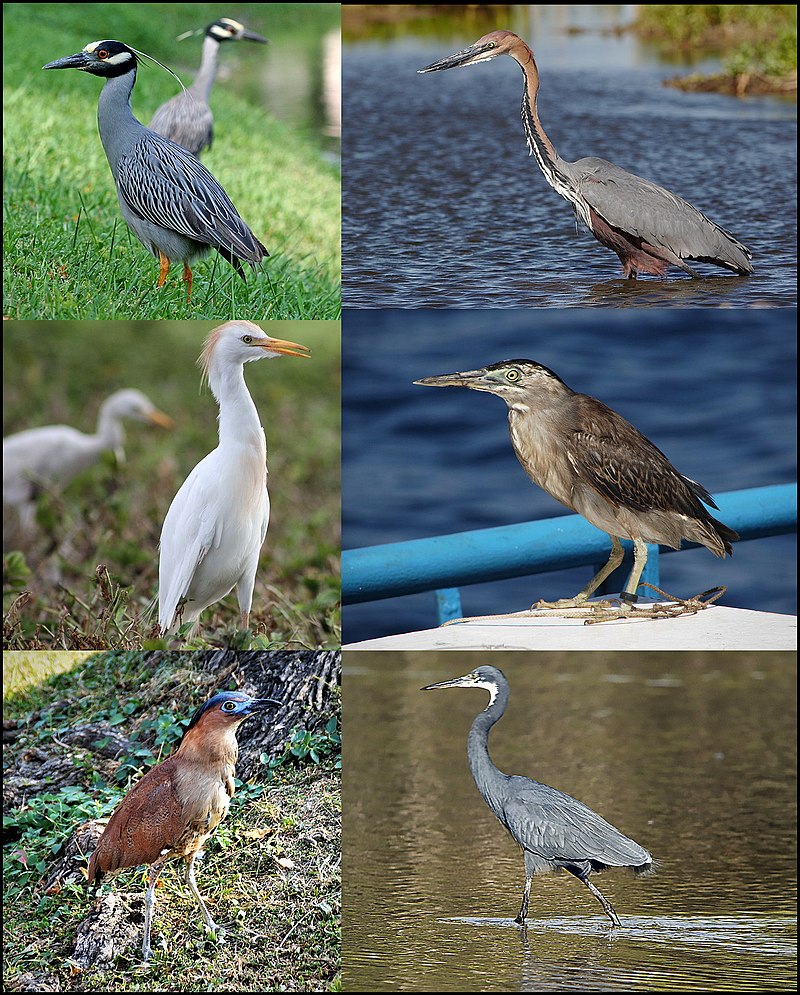
Herons are graceful and elegant birds belonging to the family Ardeidae, with 72 distinct species.
They have long legs and necks that are well-adapted for wading in shallow water like streams or ponds.
Herons can be found near freshwaters as well as along coastal areas worldwide.
Some of these species may also be referred to as egrets, bitterns, or zigzag herons/bitterns because they belong to certain genera such as Botaurus and Ixobrychus respectively.
These birds stand tall when searching for food by standing still in a shallow body of water while waiting patiently until prey appears before quickly capturing it with their sharp bills.
Scientific classification:
| Kingdom | Animalia |
| Phylum | Chordata |
| Class | Aves |
| Order | Pelecaniformes |
| Suborder | Ardei |
| Family | Ardeidae Leach, 1820 |
Also Featured In: Most Common Types of Bangladeshi Birds, Water Birds Live around Us
20. Little Blue Heron
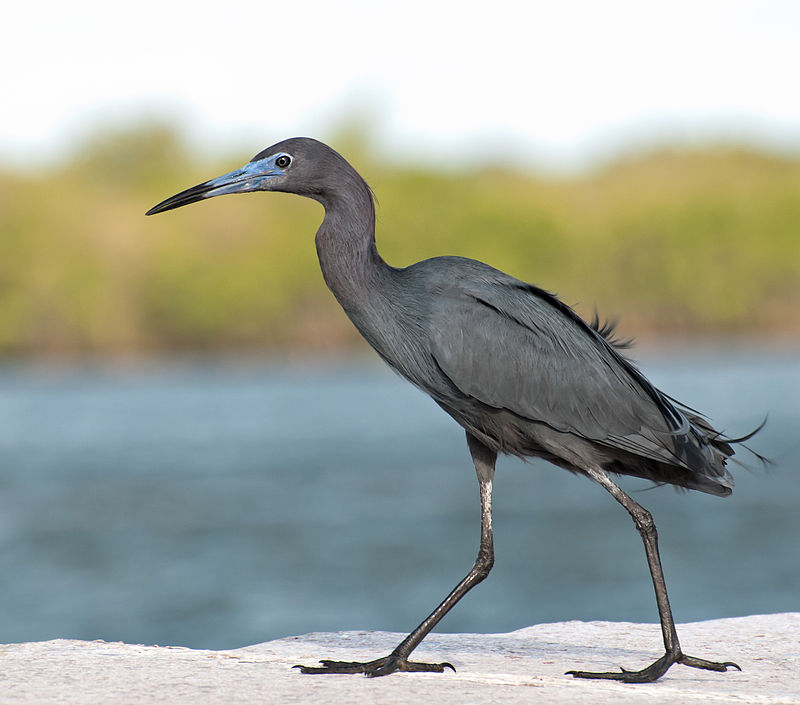
The Little Blue Heron is a small, darkly-colored heron with two-toned bill. Juveniles are completely white, similar to the Snowy Egret. In breeding season, adults develop unique coloration on their heads and legs.
The bird has an expansive habitat range that covers much of the Americas from North America down to South America.
They feed mostly in shallow water areas like tidal flats or marshes and eat small aquatic animals such as fish, frogs, and crustaceans.
This species can also be found along coastal regions where they gather at night for roosting purposes during winter months when food sources become more scarce due to the migration patterns of its prey animals.
These birds have adapted well over time allowing them to persist in most habitats throughout their wide range even despite environmental changes caused by human activities such as pollution or development projects near wetlands ecosystems which are essential for this species’ survival.
Scientific classification:
| Kingdom | Animalia |
| Phylum | Chordata |
| Class | Aves |
| Order | Pelecaniformes |
| Family | Ardeidae |
| Genus | Egretta |
| Species | E. caerulea |
Also Featured In: Top Birds Found in Mexico, Swamps Birds You Should Know
21. Crow Family
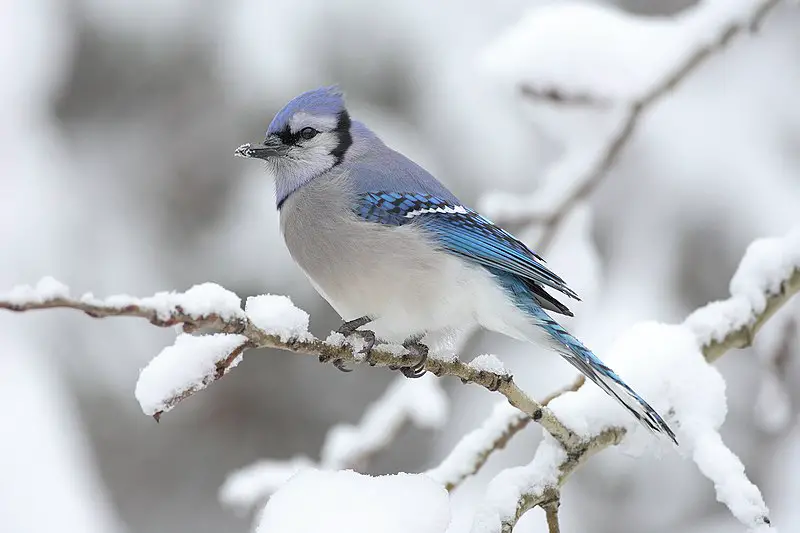
The Crow family is a cosmopolitan group of birds that contains crows, ravens, rooks, jackdaws, jays, magpies, and more.
Altogether there are 133 members in this bird family which all share similar characteristics such as large beaks and feet.
The genus Corvus alone makes up over a third of the entire crow family population with species like the common crow or blackbird being some of its most recognizable members.
All these birds have strong social bonds so they often travel in groups to find food sources or build nests together for protection against predators.
With their intelligence and adaptation skills, they can survive almost anywhere on Earth from mountains to cities making them one of the world’s most successful families of avian creatures.
Scientific classification:
| Kingdom | Animalia |
| Phylum | Chordata |
| Class | Aves |
| Order | Passeriformes |
| Superfamily | Corvoidea |
| Family | Corvidae Leach, 1820 |
Also Featured In: Common Birds in Japan, Turkey Birds You Should Know
22. Passerine
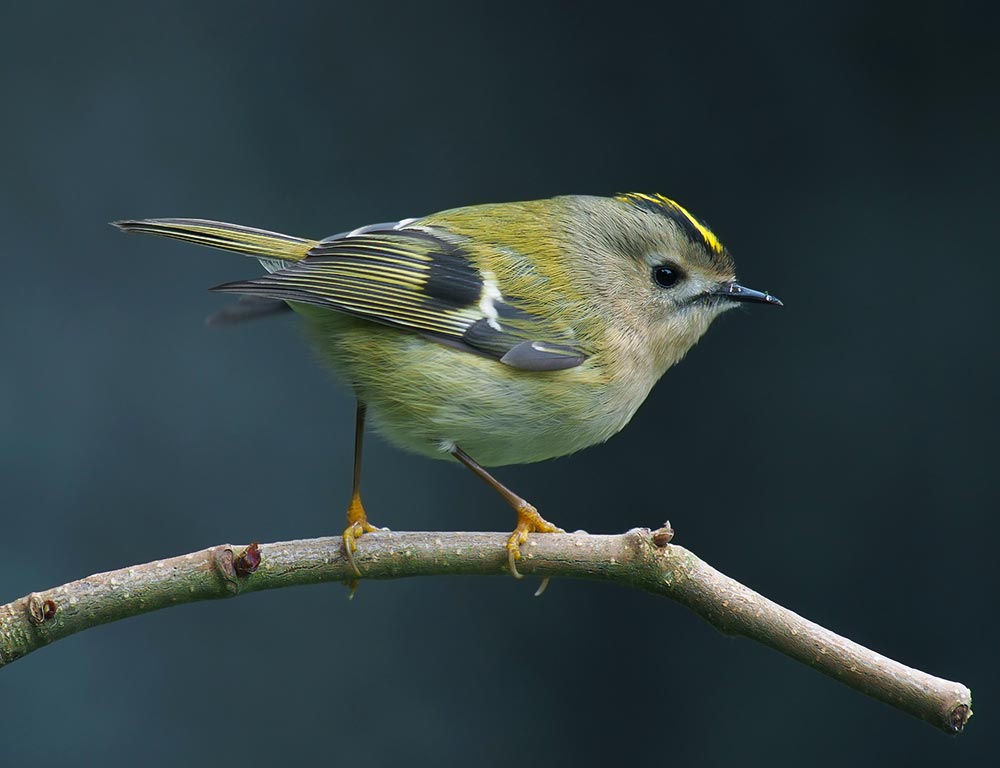
Passerines are a vast order of birds, comprising more than half the species in existence. Many familiar garden and woodland species fall into this category such as sparrows, blackbirds, finches, and warblers.
They can be recognized by their arrangement of toes; three pointing forward with one back which helps them perch on branches or wires.
Passerines range from tiny wrens to large crows and have adapted to inhabit many environments around the world including forests, mountainsides, and deserts.
They feed mainly on insects but some also consume fruit and seeds depending on their diet preferences.
Their diversity is truly remarkable from vibrant colored tropical parrots to drab winter thrushes – making passerine birds an integral part of our natural heritage.
Scientific classification:
| Kingdom | Animalia |
| Phylum | Chordata |
| Class | Aves |
| Clade | Psittacopasserae |
| Order | Passeriformes Linnaeus, 1758 |
Also Featured In: Egyptian Birds, Native Birds of Kazakhstan
23. Eurasian Blue Tit
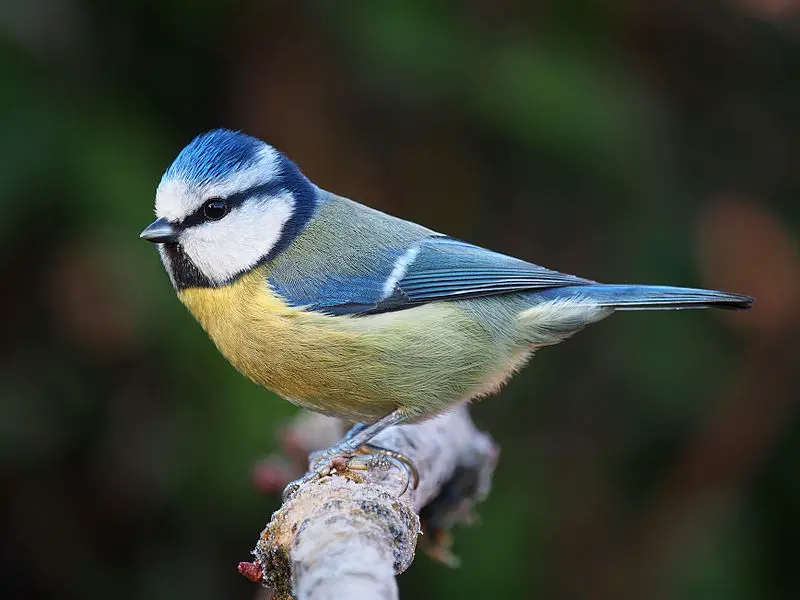
The Eurasian blue tit is a small passerine bird belonging to the Paridae family. Its bright blue and yellow plumage makes it easily recognizable, along with its small size.
They are usually resident birds that do not migrate, living throughout temperate or subarctic Europe and the western Palearctic in deciduous woodlands.
These birds breed year-round and are common residents of these areas.
Their diet consists mainly of insects but they also feed on seeds during winter months when insects become scarce.
They can be found both alone or in pairs searching for food amongst trees branches, shrubs, and grasses as well as visiting gardens for supplementary food sources such as peanut feeders provided by garden owners.
Scientific classification:
| Kingdom | Animalia |
| Phylum | Chordata |
| Class | Aves |
| Order | Passeriformes |
| Family | Paridae |
| Genus | Cyanistes |
| Species | C. caeruleus |
Also Featured In: Birds of United Kingdom, Italian Birds You Should Know
24. Starling
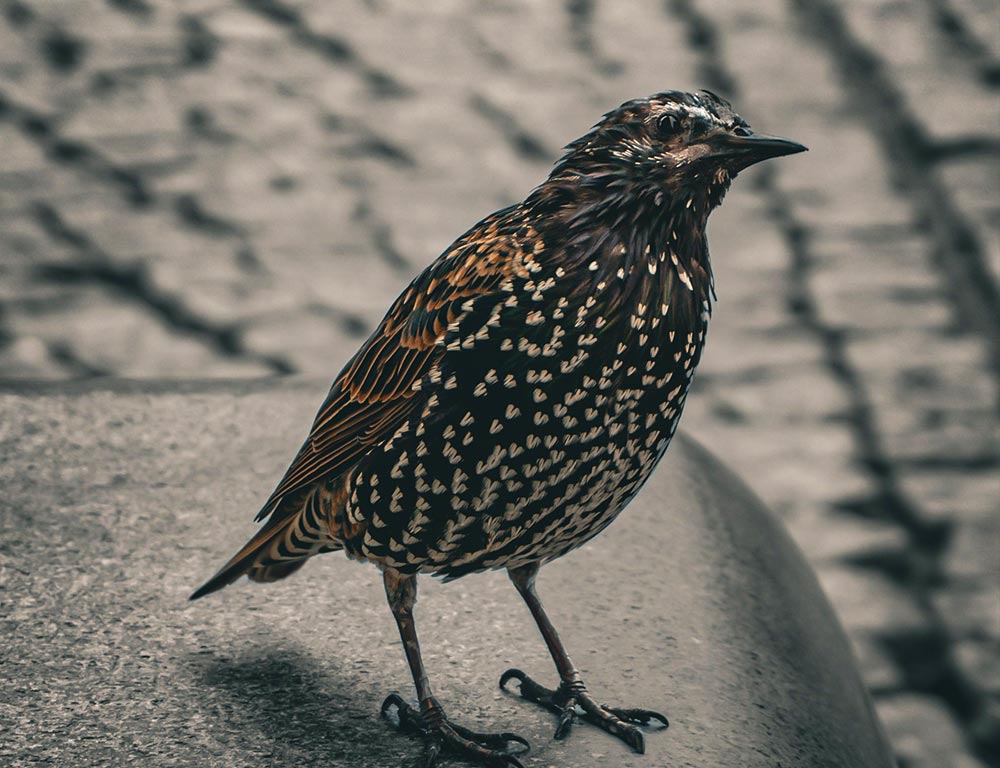
Starlings are small to medium-sized birds belonging to the Sturnidae family. They have a unique iridescent plumage, making them popularly known as glossy starlings in Africa and mynas in Asia.
Starlings inhabit Europe, Asia, and Africa; some species even migrate between continents for food or better climates.
These birds form large flocks of up to thousands at a time during their migration periods, creating spectacular visual displays while they soar through the sky.
Besides being beautiful creatures, starlings can also imitate sounds such as human speech – an impressive feat that has been documented by many ornithologists over the years.
Scientific classification:
| Kingdom | Animalia |
| Phylum | Chordata |
| Class | Aves |
| Order | Passeriformes |
| Suborder | Passeri |
| Family | Sturnidae Rafinesque, 1815 |
Also Featured In: Most Common Scotland Birds, Hong Kong Birds You Need to See
25. Red-Breasted Nuthatch

The Red-breasted Nuthatch is a beautiful and vocal songbird that can be found in coniferous forests across Canada, Alaska, the northeastern United States, and the western US.
This small bird has blue-grey upperparts with cinnamon underparts, a white throat and face with black eye stripe, a straight grey bill, and a black crown.
Its call sounds like a tin trumpet; it’s high-pitched yet nasal.
During mating season they form monogamous pairs to build their nest near tree trunks or branches at low heights off the ground where they lay 2 – 8 eggs at once.
They are very active little birds who love clinging to trees while searching for insect larvae or seeds within the bark of trees which helps control pest populations.
Scientific classification:
| Kingdom | Animalia |
| Phylum | Chordata |
| Class | Aves |
| Order | Passeriformes |
| Family | Sittidae |
| Genus | Sitta |
| Species | S. canadensis |
Also Featured In: Common Birds in Canada, Birds in Calgary You’ll Love to See
26. Cyanocitta
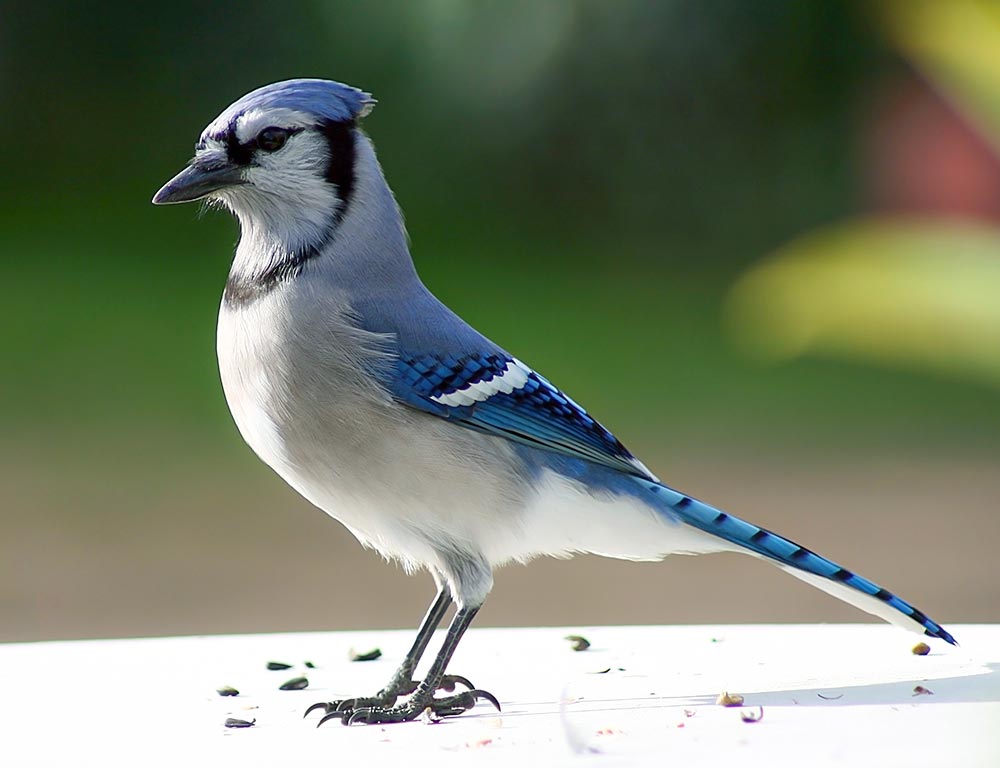
Cyanocitta is a genus of birds belonging to the Corvidae family, which includes crows, jays, and magpies. It was established in 1845 by Hugh Edwin Strickland and consists of four species: Steller’s Jay, Blue Jay, Clark’s Nutcracker, and Gray Jay.
The name is Cyanocitta comes from two Greek words – kuanos meaning “dark blue” and kitta meaning “jay” – which perfectly describes these colorful birds with their bright feathers that range from deep blues to light grays.
They are also known for being very intelligent animals as they can solve complex problems such as opening boxes or finding food hidden under rocks.
As well as this impressive ability, Cyanocittas have been known to mimic human voices.
Scientific classification:
| Kingdom | Animalia |
| Phylum | Chordata |
| Class | Aves |
| Order | Passeriformes |
| Family | Corvidae |
| Genus | Cyanocitta Strickland, 1845 |
Also Featured In: Common Blue Birds of United States of America,
27. Great Blue Heron

The Great Blue Heron is a majestic wading bird found in many parts of North America, Central America, the Caribbean, and even as far away as the Galapagos Islands.
It has an impressive wingspan which can reach up to six feet wide. Its feathers are mainly bluish-gray with brownish streaks on both its neck and chest while its head displays white plumes.
The adult herons can also be identified by their yellow bill and legs.
They live near bodies of water such as lakes, marshes, or rivers where they feed on fish using a spear-like motion with their sharp bills.
An all-white population exists only in South Florida and the Florida Keys making it unique.
Scientific classification:
| Kingdom | Animalia |
| Phylum | Chordata |
| Class | Aves |
| Order | Pelecaniformes |
| Family | Ardeidae |
| Genus | Ardea |
| Species | A. herodias |
Also Featured In: Birds that Live in the Deserts, Flight Birds You Should Know
28. Black-Throated Blue Warbler
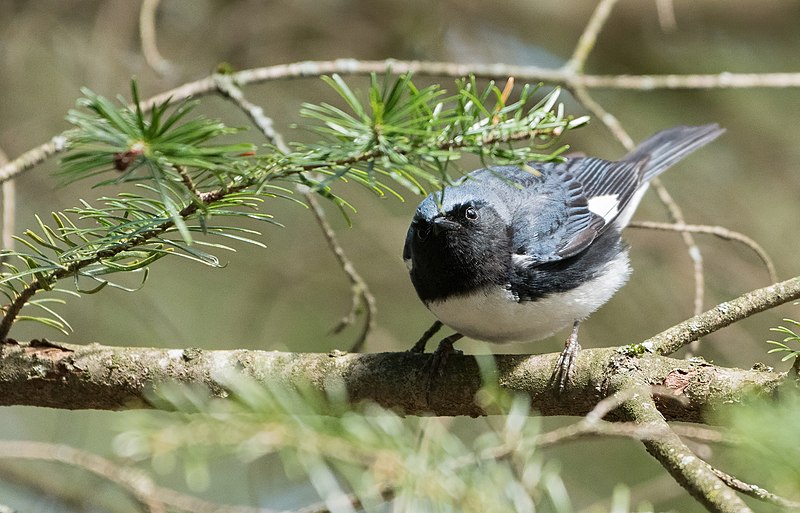
The black-throated blue warbler is a beautiful bird from the New World Warbler family. It breeds in deciduous and mixed coniferous forests of eastern North America, migrating to islands in the Caribbean and Central America during winter months.
This small passerine has impressive plumage with bright blue upperparts and white underparts that contrast sharply against its coal-black throat patch.
Its wings are dark greyish or olive green with two bold white wing bars on each side; while its tail feathers are yellowish or whitish underneath but gray above.
These birds feed mainly on insects such as moths, beetles, ants, grasshoppers, and spiders which they catch by flycatching from low branches or shrubs within their habitat range.
Rarely found in western Europe, it is considered to be non-indigenous there although some individuals have been observed over short periods.
Scientific classification:
| Kingdom | Animalia |
| Phylum | Chordata |
| Class | Aves |
| Order | Passeriformes |
| Family | Parulidae |
| Genus | Setophaga |
| Species | S. caerulescens |
Also Featured In: Most Common Types of Birds Found in Cuba, Birds of Nova Scotia
29. Blue Grosbeak
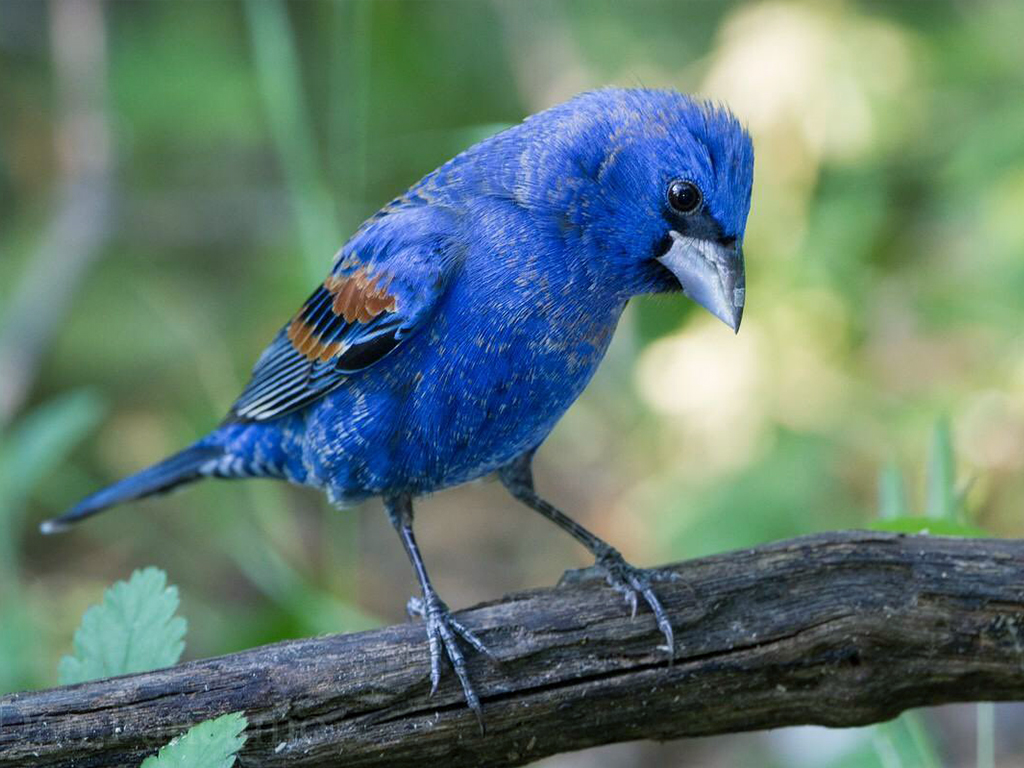
The Blue Grosbeak is a medium-sized North American passerine bird from the Cardinalidae family. It has striking plumage, with males showing off an impressive blue coloration and two brown wing bars.
Females are mainly brown with scattered blue feathers on the upperparts, but they also have two brown wing bars like males do.
During summer months these birds can be found in northern Mexico and the southern United States where they breed, while during wintertime they migrate to Central America for resting purposes.
This beautiful species of bird is easy to spot due to its vibrant colors making it a popular sight amongst wildlife observers.
Scientific classification:
| Kingdom | Animalia |
| Phylum | Chordata |
| Class | Aves |
| Order | Passeriformes |
| Family | Cardinalidae |
| Genus | Passerina |
| Species | P. caerulea |
Also Featured In: El Salvador Birds, Spring Birds that Live around Us
30. Blue-Headed Parrot
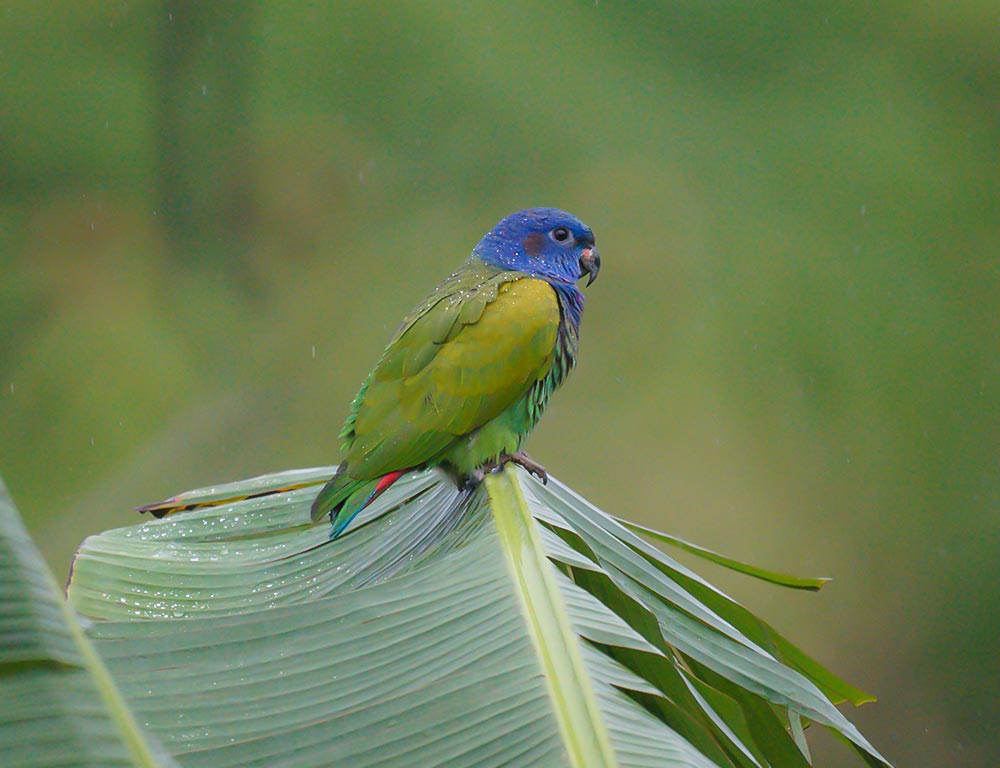
The Blue-headed Parrot is a stunning bird native to South and Central America. It measures around 27 cm in length, with its body mostly green, blue head and neck, and red undertail coverts.
This beautiful parrot lives in tropical or subtropical forests as well as savannas where it feeds on fruits such as figs, nuts, and mangos.
In the wild, they are often seen flying in small groups of up to 10 birds that chatter loudly.
They make excellent pets too due to their intelligence but require lots of attention from owners who should provide plenty of toys for them so they don’t get bored.
All in all these amazing creatures will bring joy into any home or garden.
Scientific classification:
| Kingdom | Animalia |
| Phylum | Chordata |
| Class | Aves |
| Order | Psittaciformes |
| Family | Psittacidae |
| Genus | Pionus |
| Species | P. menstruus |
Also Featured In: Panama Birds, Case Birds that Live in with Us
31. Indigo Bunting
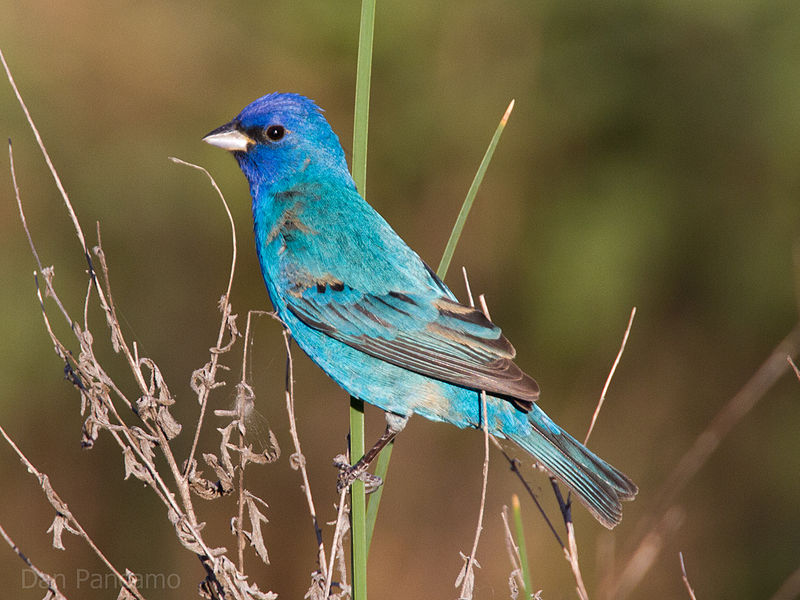
The Indigo Bunting is a small bird in the cardinal family, found throughout North and South America.
It has an unmistakable bright blue plumage that stands out against its natural habitat of farmland, brush areas, and open woodland.
During breeding season it can be seen from southern Canada to northern Florida while during winter months it migrates south towards Central and Northern South America.
The Indigo Bunting prefers to migrate at night using the stars as navigation aids.
This species feeds on insects and seeds which they find near the ground or catch mid-flight with their agile wingspan.
An iconic sight for many farmers across both continents, these birds are a welcome addition to any backyard oasis or wildflower meadow.
Scientific classification:
| Kingdom | Animalia |
| Phylum | Chordata |
| Class | Aves |
| Order | Passeriformes |
| Family | Cardinalidae |
| Genus | Passerina |
| Species | P. cyanea |
Also Featured In: Georgia Birds, Small Kentucky Birds
32. Blue Waxbill
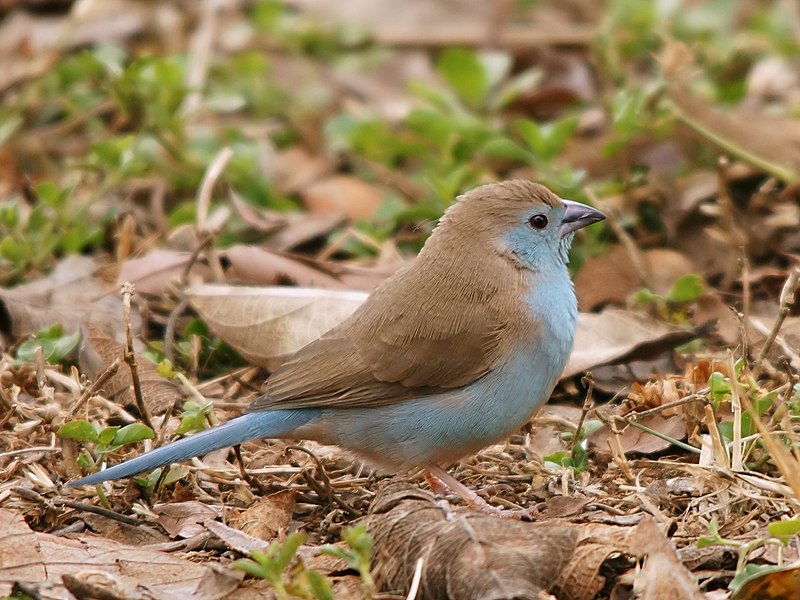
The Blue Waxbill is a species of estrildid finch native to Southern Africa, and it is also quite popular in aviary bird-keeping.
It features blue feathers on its head and throat, as well as a bright orange breast – giving it the “cordon-bleu” name.
This small songbird has an average length of 5 inches and can be found amongst shrubs or grassland habitats near water sources such as rivers or lakes.
The diet typically consists mainly of seeds supplemented by insects for additional nutrients during the breeding season.
They are usually seen in pairs or family groups which become highly territorial during nesting time; they build their nests using fine blades of grass woven together with spider webs.
Despite being heavily hunted by humans for meat consumption purposes, this beautiful bird population continues to thrive today thanks to conservation efforts.
Scientific classification:
| Kingdom | Animalia |
| Phylum | Chordata |
| Class | Aves |
| Order | Passeriformes |
| Family | Estrildidae |
| Genus | Uraeginthus |
| Species | U. angolensis |
Also Featured In: Sao Tome & Principe Birds, Birds that You’ll Find in Kruger national park
33. Blue-Gray Gnatcatcher
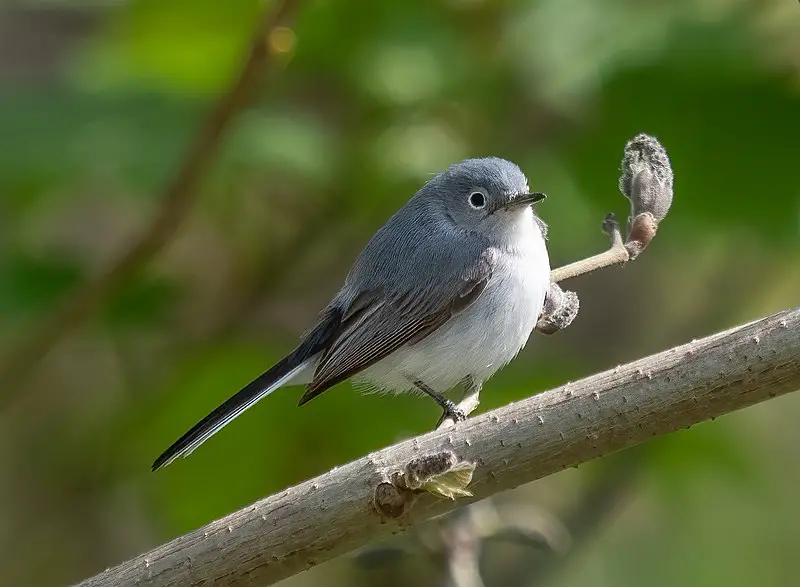
The Blue-gray Gnatcatcher is a beautiful small songbird native to North America. It has a length of 10–13 cm (3.9–5.1 in), a wingspan of 6.3 in (16 cm), and weighs only 5–7 g (0.18–0.25 oz).
Males have blue-gray upperparts with white underparts, slender dark bills, and long black tails edged in white; females are less vibrant but still eye-catching.
Juveniles are brownish-gray overall but may show some hints of the adult coloration around their tails or shoulders as they mature into adulthood.
Their diet consists mainly of insects which they catch while flitting through air like tiny darts.
This stunning species can be found anywhere from woodlands to urban parks so keep your eyes peeled for these delightful creatures on your next outdoor adventure.
Scientific classification:
| Kingdom | Animalia |
| Phylum | Chordata |
| Class | Aves |
| Order | Passeriformes |
| Family | Polioptilidae |
| Genus | Polioptila |
| Species | P. caerulea |
Also Featured In: Chickadees Birds, Birds That Live in Colorado
34. Tree Swallow
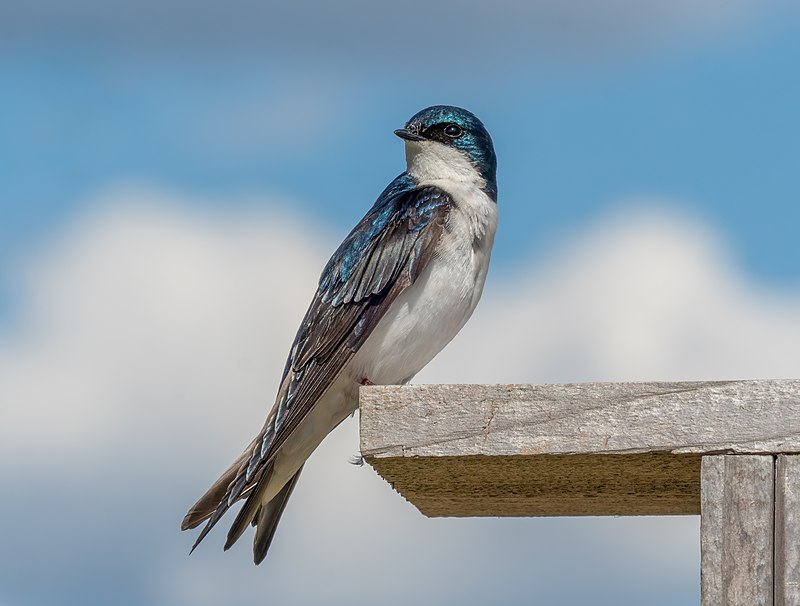
The Tree Swallow is a migratory bird of the Hirundinidae family, first described by French ornithologist Louis Vieillot in 1807. It has glossy blue-green upperparts and white underparts with iridescent violet on its throat and breast.
Its wings are blackish above with pale grey below, while its tail feathers are blackish-blue with white edges.
During breeding season they build cup-shaped nests out of grasses or twigs which are lined with animal hair or fur found near their nesting sites.
They feed mainly on insects such as flies and beetles that they catch while flying over fields or water surfaces during summer months when food is abundant for them to survive migration back southward in wintertime.
The tree swallow is an important part of our environment both aesthetically and ecologically due to its insectivorous diet helping keep pest populations low in certain areas where crops may otherwise be damaged without these birds around.
Scientific classification:
| Kingdom | Animalia |
| Phylum | Chordata |
| Class | Aves |
| Order | Passeriformes |
| Family | Hirundinidae |
| Genus | Tachycineta |
| Species | T. bicolor |
Also Featured In: Swallows Species, House Birds You’ll Love to Pet
35. Cliff Swallow
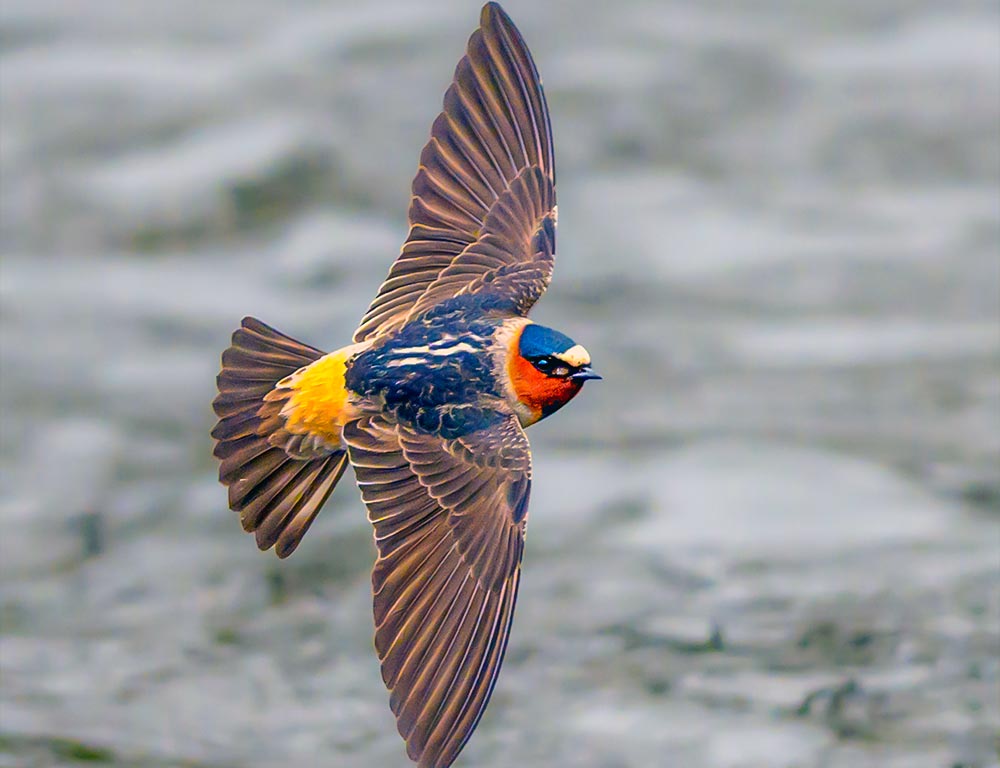
The Cliff swallow, or American cliff swallow (Petrochelidon pyrrhonota) is a species of passerine bird belonging to the family Hirundinidae. They are commonly found in North and South America.
These birds have an unmistakable appearance with their bright orange foreheads and flame-colored backs that make them stand out from other swallows.
Cliff swallows form large colonies when nesting on cliffsides which makes them very social creatures; they often feed together while flying around fields or rivers looking for insects to eat.
In addition, they use mud pellets to build cup-shaped nests under bridges and eaves of buildings near water sources such as lakes, rivers, and marshes – usually close to human dwellings.
Overall, these fascinating birds are both beautiful to look at and practical too — providing insect pest control services through feeding on flies and mosquitoes in return for humans’ protection – what could be better?
Scientific classification:
| Kingdom | Animalia |
| Phylum | Chordata |
| Class | Aves |
| Order | Passeriformes |
| Family | Hirundinidae |
| Genus | Petrochelidon |
| Species | P. pyrrhonota |
Also Featured In: Birds Live Near San Diego, Birds that Live in San Francisco Bay Area
36. Purple Martin
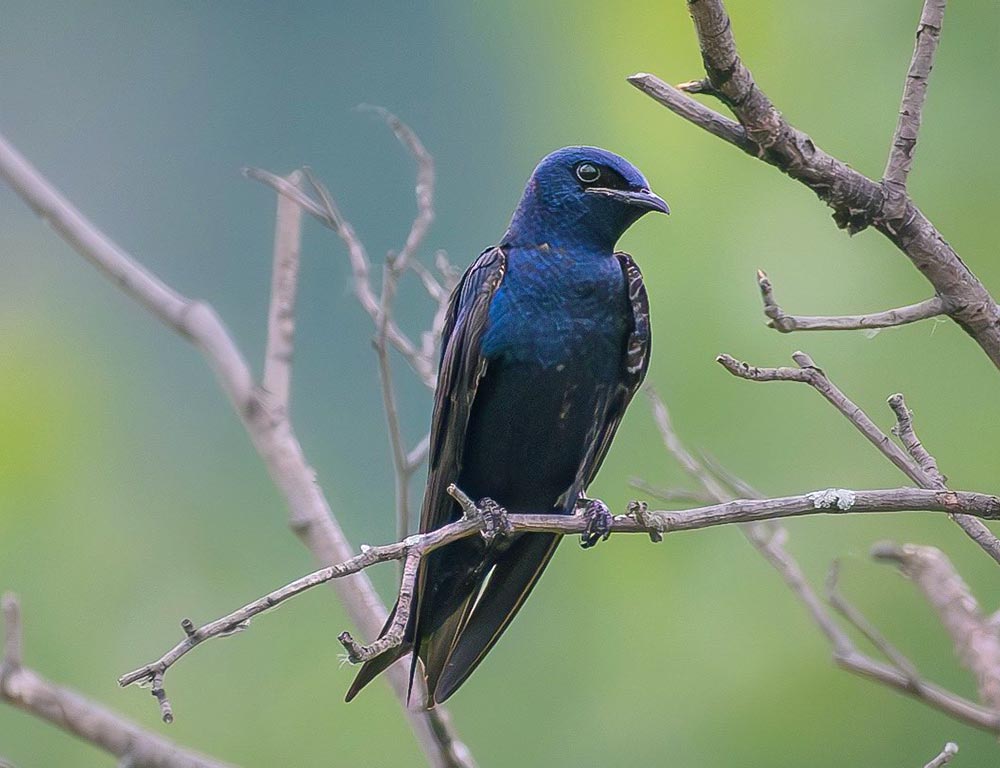
The Purple Martin is a beautiful passerine bird in the swallow family and is the largest of its kind in North America.
It has dark blackish-blue feathers that have an iridescent sheen which can make them appear blue or deep purple depending on the light; they may even look green.
These birds are quite social creatures and often build communal roosts with multiple nests, having as many as hundreds of individuals living together at once.
They feed mainly on flying insects such as flies, moths, wasps, and bees.
Their habitats include areas near bodies of water like lakes or rivers where there’s plenty for these birds to eat all year round.
The Purple Martin is truly an amazing species worth protecting.
Scientific classification:
| Kingdom | Animalia |
| Phylum | Chordata |
| Class | Aves |
| Order | Passeriformes |
| Family | Hirundinidae |
| Genus | Progne |
| Species | P. subis |
Also Featured In: Magenta Birds You Didn’t Know, Central Texas Birds
37. Western Bluebird
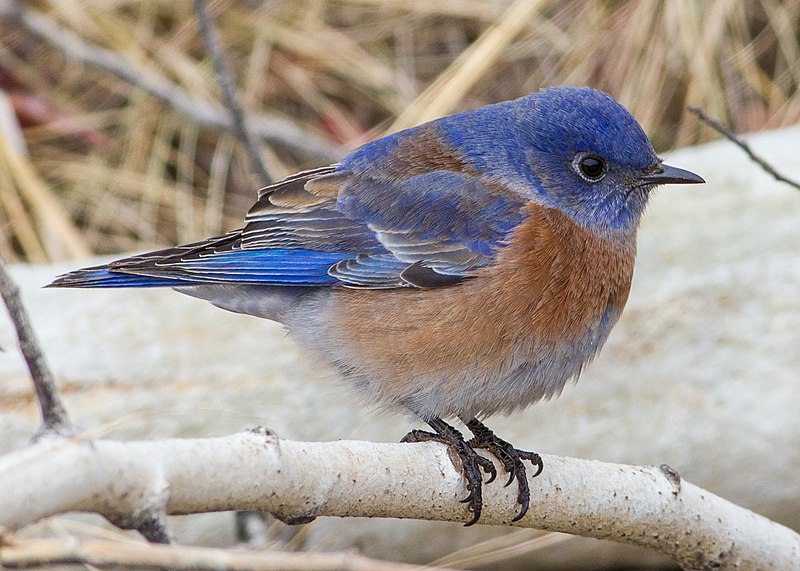
The Western Bluebird is a small North American thrush that was formally described by English naturalist William John Swainson in 1832.
It has six subspecies and measures 15 to 18 cm long, with the adult male being bright blue on top and light orange-brown underneath.
Its wings have white bars which contrast against its bright plumage. The female is duller overall but retains the same wing pattern as its counterpart.
In addition, it also sports an attractive reddish patch near its bill area when breeding season arrives.
This species can be found inhabiting open woodlands, grassy meadows, or agricultural areas of western America from Alaska southwards into Mexico and Guatemala where they feed mainly on insects such as beetles, flies, ants, etc.
All in all this gorgeous bird adds colour to any environment.
Scientific classification:
| Kingdom | Animalia |
| Phylum | Chordata |
| Class | Aves |
| Order | Passeriformes |
| Family | Turdidae |
| Genus | Sialia |
| Species | S. mexicana |
Also Featured In: Thrush Species, Common Southern Californian Birds
38. California Scrub Jay
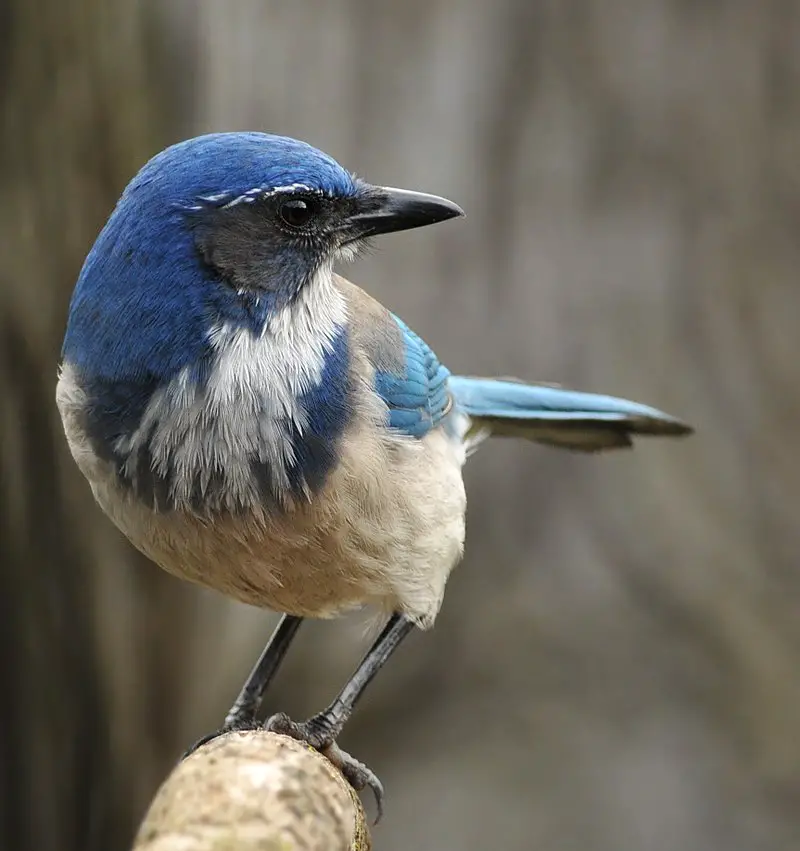
The California scrub jay is a species of bird native to western North America. It can be found from southern British Columbia all the way down through California and western Nevada near Reno, up to west beyond the Sierra Nevada range.
This beautiful blue feathered bird was once categorized with Woodhouse’s scrub jay as the “western scrub jay” along with island scrub jays.
The California Scrub Jay has distinctive features such as its greyish-blue feathers on its head, wings and tail; white cheeks; dark bill; and strong legs for perching in trees which makes it stand out among other birds in its family.Scientific classification:
| Kingdom | Animalia |
| Phylum | Chordata |
| Class | Aves |
| Order | Passeriformes |
| Family | Corvidae |
| Genus | Aphelocoma |
| Species | A. californica |
Also Featured In: Common Californian Birds, Summer Birds that Live around Us
39. Painted Bunting
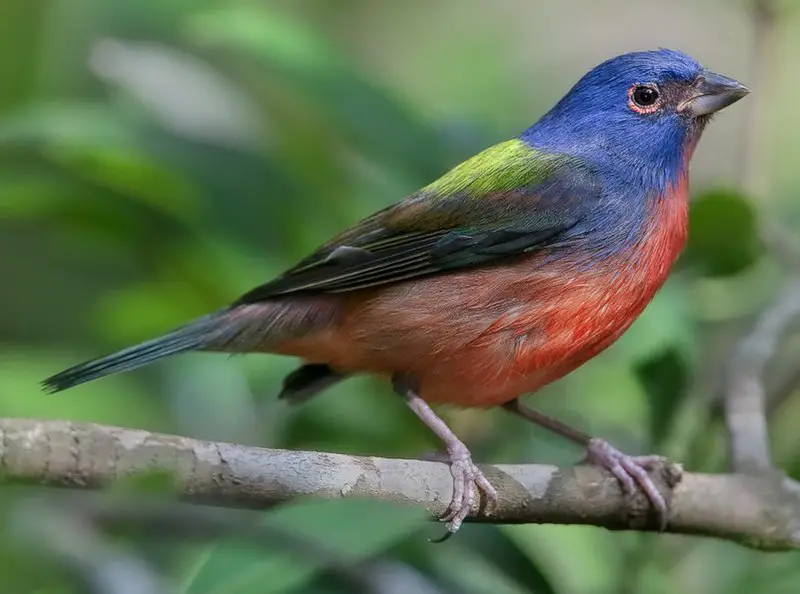
The Painted Bunting is an eye-catching bird from the Cardinal family, native to North America. It was first described by Carl Linnaeus in his eighteenth-century Systema Naturae.
The males of this species are particularly striking; they have brightly coloured plumage which only appears after their second year of life and can be distinguished from female birds through close inspection.
These colorful songbirds are a delight for any avid birder, with their vibrant hues bringing joy to nature lovers everywhere.
They often inhabit woodland areas where there is plenty of seed and insects available for them to feed on – as well as some shrubbery so that they can hide away safely when needed.
Scientific classification:
| Kingdom | Animalia |
| Phylum | Chordata |
| Class | Aves |
| Order | Passeriformes |
| Family | Cardinalidae |
| Genus | Passerina |
| Species | P. ciris |
Also Featured In: Texas Birds, Flocks Birds around Us
40. Florida Scrub Jay
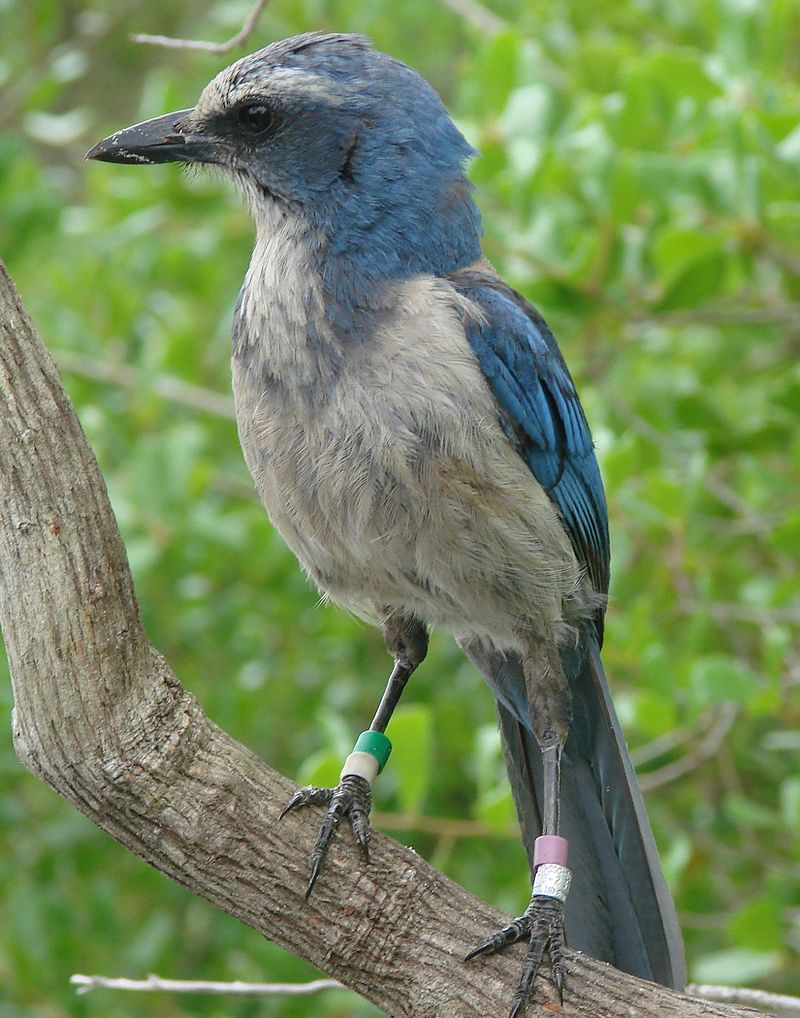
The Florida scrub jay is an important native bird species, endemic to the state of Florida and found nowhere else in the world. It has been around for at least two million years, making it a unique part of Floridian wildlife.
These birds are known for their distinctive blue-gray coloration with lighter underparts and white streaks across their wings.
They also have long legs and short tails that help them move quickly through open areas like sandy prairies or pinelands.
Scrub Jays feed mainly on insects but will take advantage of any food sources they find including fruit, nuts, eggs, small reptiles, or amphibians if available.
Due to its restricted range this species is keenly sought by birders who want a chance to spot one in its natural habitat.
Scientific classification:
| Kingdom | Animalia |
| Phylum | Chordata |
| Class | Aves |
| Order | Passeriformes |
| Family | Corvidae |
| Genus | Aphelocoma |
| Species | A. coerulescens |
Also Featured In: Florida Birds, Birds that Live around Central Florida
41. American Purple Gallinule
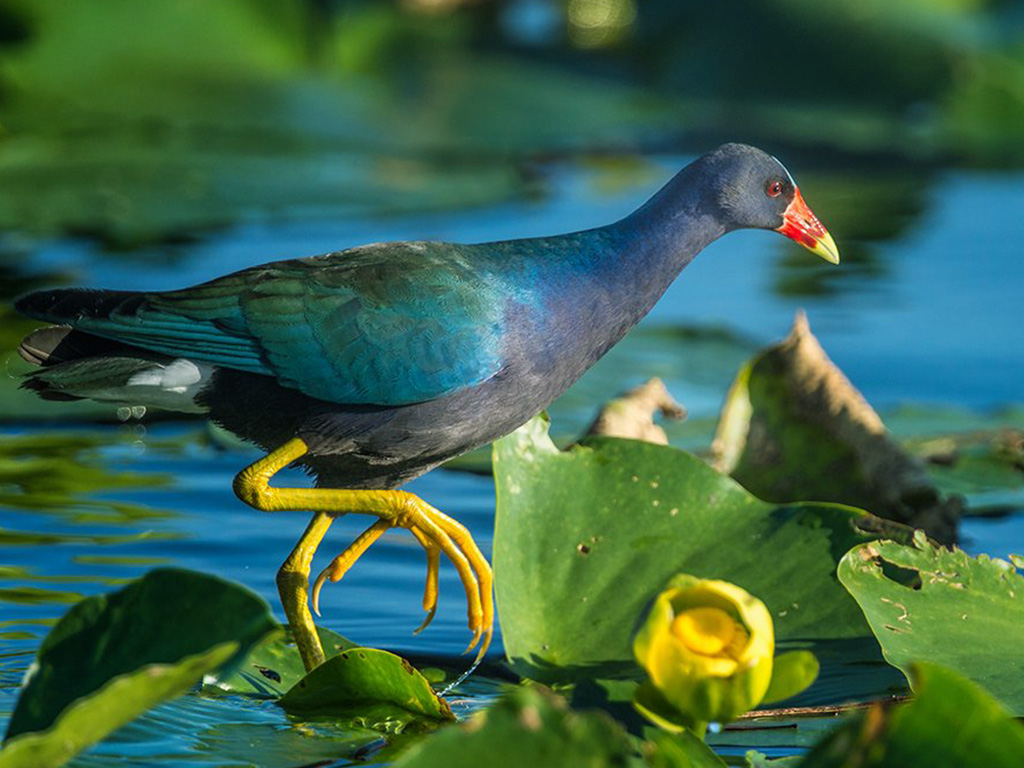
The American purple gallinule is a stunning bird found in North and South America. This species belongs to the order Gruiformes, which contains cranes, rails, and crakes.
The family Rallidae classifies it as a rail species with its scientific name being Porphyrio martinica.
It is also known locally as the yellow-legged gallinule due to its striking plumage of greenish-blue feathers on its wings, back, and tail along with bright red legs and bill.
Its environment includes freshwater marshes, swamps, or paddy fields where these birds feed mostly on plants like water lilies or small invertebrates such as insects or molluscs.
These beautiful creatures are threatened by habitat destruction, especially for agricultural purposes but conservation efforts are helping them survive despite this threat.
Scientific classification:
| Kingdom | Animalia |
| Phylum | Chordata |
| Class | Aves |
| Order | Gruiformes |
| Family | Rallidae |
| Genus | Porphyrio |
| Species | P. martinicus |
Also Featured In: Everglades Birds, Caribbean Birds
42. Cerulean Warbler
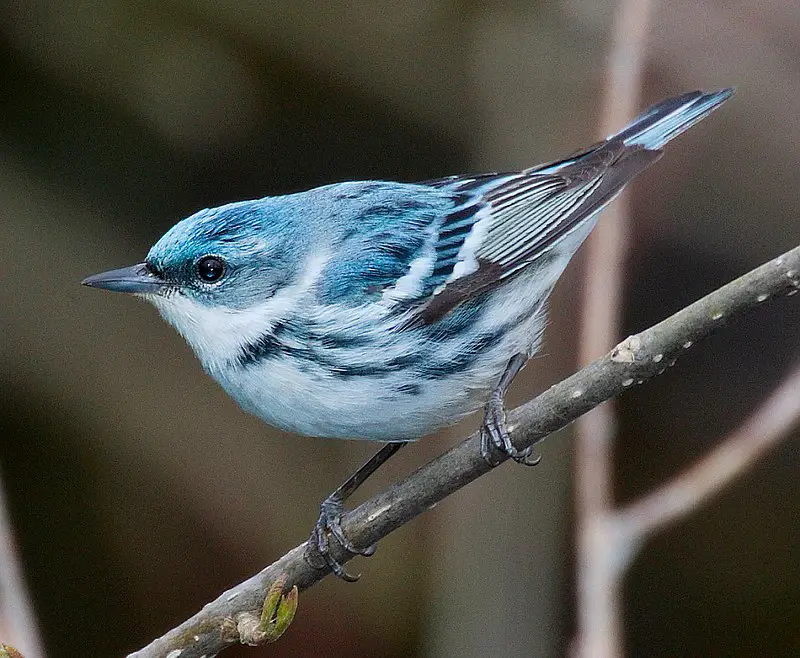
The Cerulean Warbler is a small songbird in the Parulidae family. It migrates long distances, breeding in eastern North American hardwood forests and spending its non-breeding season on the east slope of the Andes in South America.
This bird displays strong sexual dichromatism with adult males having vivid cerulean blue and white upperparts with black streaks running down their neck to the chest area.
Females have an olive green color above with yellowish tones beneath them, along with some dark streaks as well.
These birds feed mainly on insects but also consume fruits during migration or when rearing young ones.
They make nests near tree trunks and lay three to five eggs per clutch which hatch after about 10 days of incubation by both parents.
The Cerulean Warbler is classified as Near Threatened due to human disturbances such as habitat loss caused by deforestation amongst other factors like climate change that threaten this species’ survival.
Scientific classification:
| Kingdom | Animalia |
| Phylum | Chordata |
| Class | Aves |
| Order | Passeriformes |
| Family | Parulidae |
| Genus | Setophaga |
| Species | S. cerulea |
Also Featured In: Louisiana Birds, Birds Commonly Found in New York
43. Northern Parula
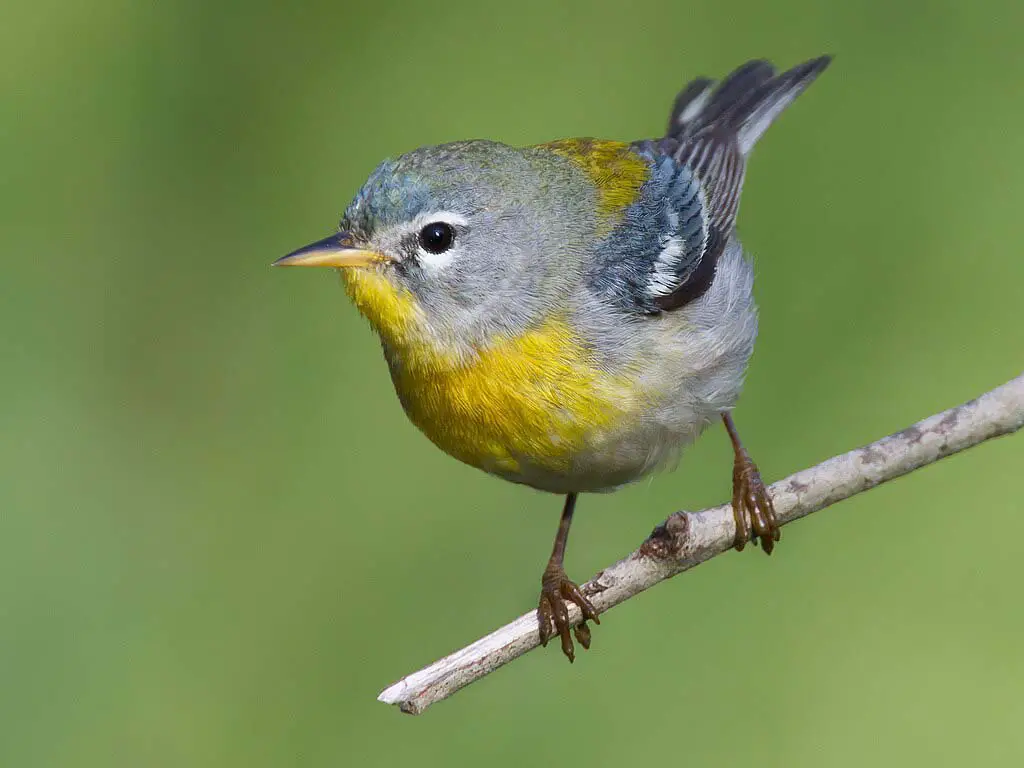
The Northern Parula is a small, migratory warbler native to North America. It measures between 4.3 and 4.9 inches in length and has a wingspan of 6.3-7.1 inches wide.
Its plumage consists mainly of yellowish-green upper parts with an orange patch on its chest as well as blue crowns for males during the breeding season.
Females have duller colors than their male counterparts overall but are still quite striking from afar.
This species breeds primarily in eastern Canada down through Florida, though some northern populations may migrate southward come wintertime while others stick around year round depending on the weather conditions they face each year – truly amazing adaptability sets them apart from other birds in this region.
Scientific classification:
| Kingdom | Animalia |
| Phylum | Chordata |
| Class | Aves |
| Order | Passeriformes |
| Family | Parulidae |
| Genus | Setophaga |
| Species | S. americana |
Also Featured In: Maine Birds, Adirondack Mountain Birds
44. Steller’s Jay
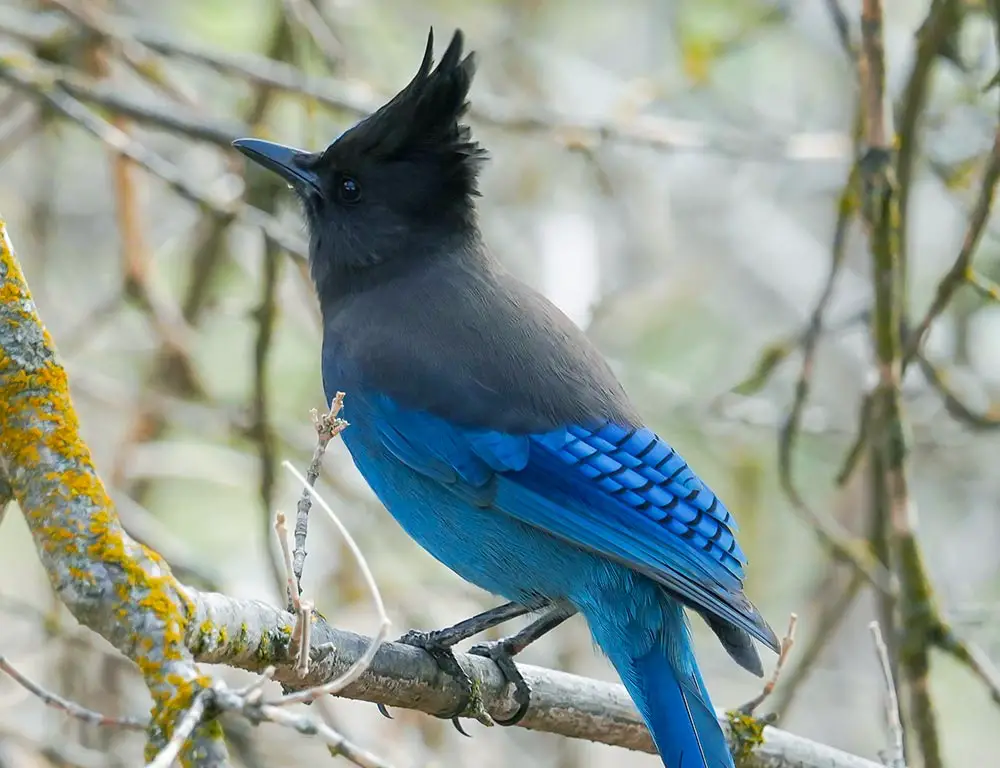
Steller’s jay is a beautiful and colorful bird native to western North America and the mountains of Central America.
It has a distinctive long crest that sets it apart from other birds, with its blue feathers streaked with black, white, gray, and brown markings.
This species is closely related to the blue jays found in eastern North America but can be distinguished by their longer crests.
They are known for being highly vocal birds who like to make loud calls throughout forests they inhabit as well as stealing food from unsuspecting mammals or raiding bird feeders when given the chance.
Steller’s Jays have adapted well to human presence in areas they populate making them great backyard visitors if you’re lucky enough.
Scientific classification:
| Kingdom | Animalia |
| Phylum | Chordata |
| Class | Aves |
| Order | Passeriformes |
| Family | Corvidae |
| Genus | Cyanocitta |
| Species | C. stelleri |
Also Featured In: Alaska Birds, Birds That Live around Seattle
45. Lazuli Bunting
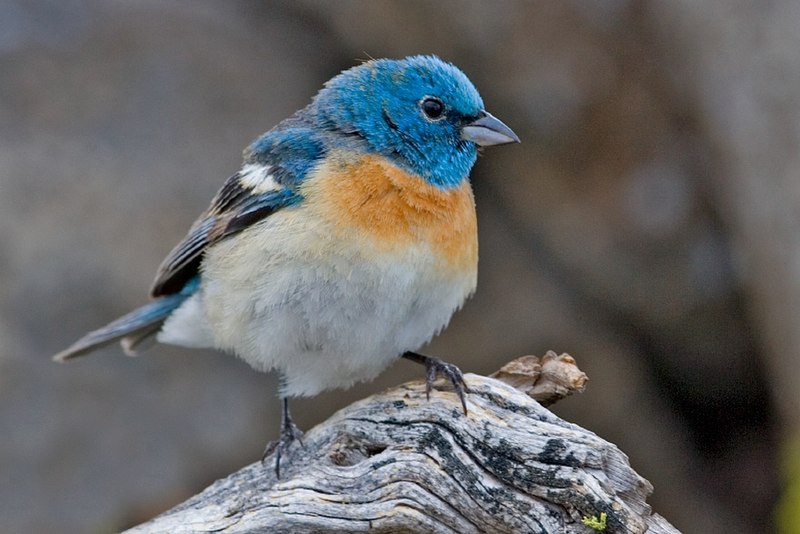
The Lazuli Bunting is a beautiful North American songbird, aptly named for its bright blue head and back that resemble the gemstone lapis lazuli.
With white wing bars contrasting against its light rusty breast and white belly, it stands out from other birds.
Measuring only 11-13 centimeters in length, this small bird holds an unmistakable beauty with distinct coloring which sets it apart from eastern or western bluebirds of similar size.
The male’s brilliant hues have made them popular among birdwatchers throughout the United States as they migrate along their yearly route each spring and summer to breed before returning southward again come fall.
Scientific classification:
| Kingdom | Animalia |
| Phylum | Chordata |
| Class | Aves |
| Order | Passeriformes |
| Family | Cardinalidae |
| Genus | Passerina |
| Species | P. amoena |
Also Featured In: birds of Idaho, Blue Birds that You’ll Find in Utah
46. Typical Swallows
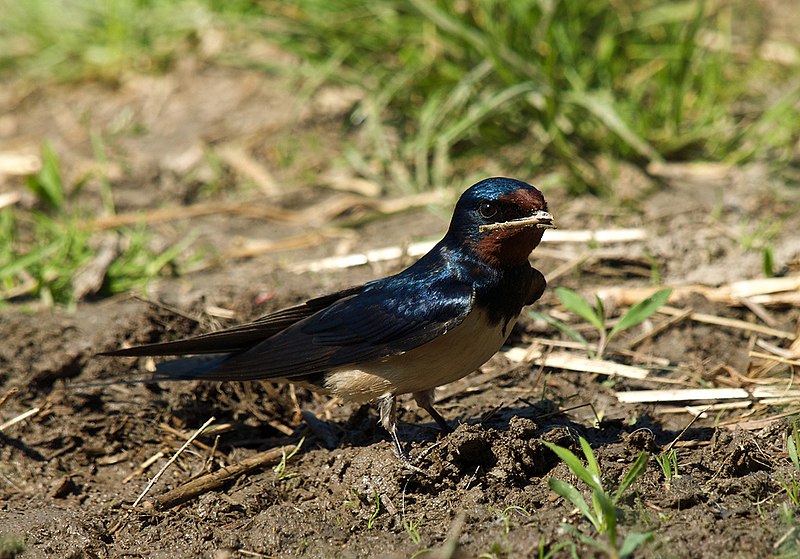
The typical swallows are a group of passerine birds in the family Hirundinidae. They belong to the bird genus Hirundo, which is the largest in its family with 15 different species.
The term hirundo means swallow in Latin. These birds typically have blue backs, red faces, and either a rufous or whitish underbelly. One of the most widespread species in this group is the barn swallow.
Scientific classification:
| Kingdom | Animalia |
| Phylum | Chordata |
| Class | Aves |
| Order | Passeriformes |
| Family | Hirundinidae |
| Subfamily | Hirundininae |
| Genus | Hirundo Linnaeus, 1758 |
47. Aphelocoma
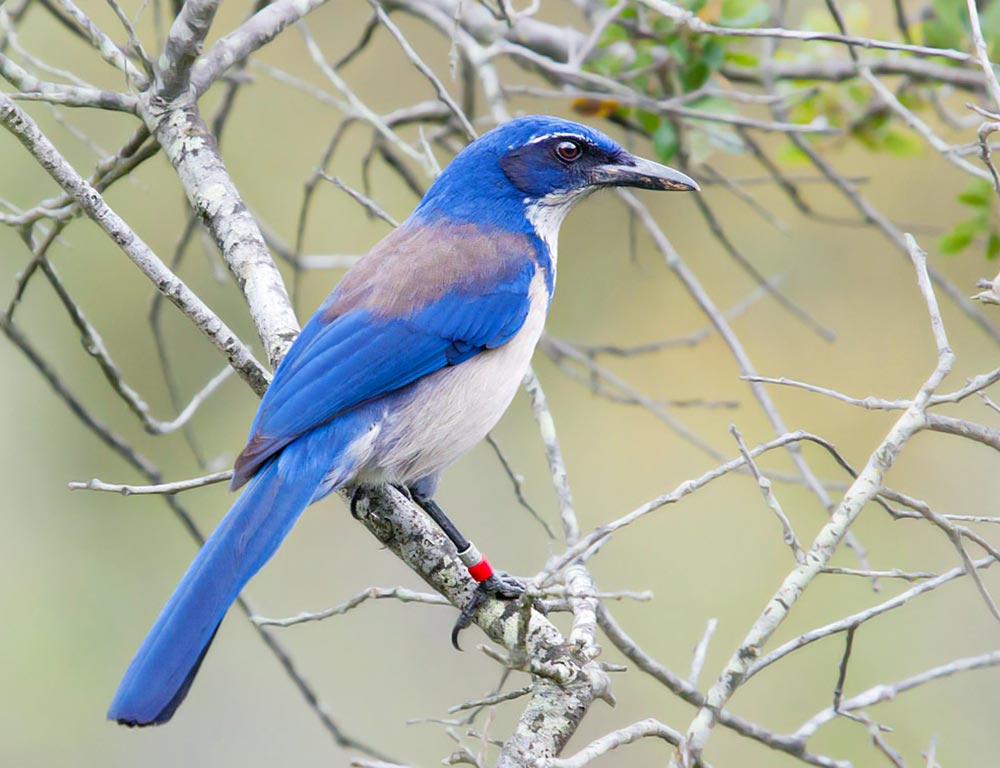
Aphelocoma birds are passerine birds that belong to the New World jays family. They are found in Mexico, western Central America, the western United States, and Florida.
These birds include scrub jays and their relatives. Unlike other jays, magpies, or treepies, Aphelocoma jays form a distinct subfamily, likely due to their unique genetic background.
These birds are typically found in scrublands, deserts, and woodland habitats, with some species adapting to urban areas.
They have a varied diet consisting of nuts, seeds, insects, and occasionally small vertebrates.
Aphelocoma birds are known for their intelligence, problem-solving abilities, and vocalization skills, as they use a range of calls to communicate with each other.
They typically mate for life and are monogamous. Some species of Aphelocoma birds, such as the Florida scrub jay, are considered threatened or endangered due to habitat loss and human interference.
Scientific classification:
| Kingdom | Animalia |
| Phylum | Chordata |
| Class | Aves |
| Order | Passeriformes |
| Family | Corvidae |
| Genus | Aphelocoma Cabanis, 1851 |
48. Mexican Jay
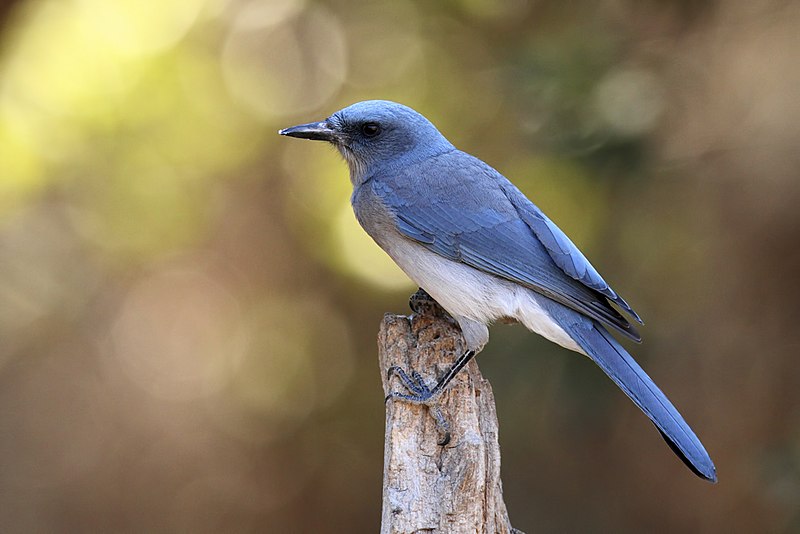
The Mexican jay, previously known as the gray-breasted jay, is a species of New World jay native to regions including the Sierra Madre Oriental, Sierra Madre Occidental, and Central Plateau of Mexico.
It also inhabits select areas in the southwestern United States. The Mexican jay was recently split into two species, with the other being known as the Transvolcanic jay.
These birds are known for their striking blue plumage and are often found in small groups.
They are opportunistic feeders, consuming a wide variety of food, including insects, fruits, seeds, and even small vertebrates.
The Mexican jay’s habitat includes woodlands, forests, and desert scrub. Due to habitat loss and fragmentation, their population is slowly declining, making them a conservation concern.
Scientific classification:
| Kingdom | Animalia |
| Phylum | Chordata |
| Class | Aves |
| Order | Passeriformes |
| Family | Corvidae |
| Genus | Aphelocoma |
| Species | A. wollweberi |
Also Featured In: Most Common Birds of Nuevo Leon, Birds You’ll Find in Sonoran
49. Red-Flanked Bluetail
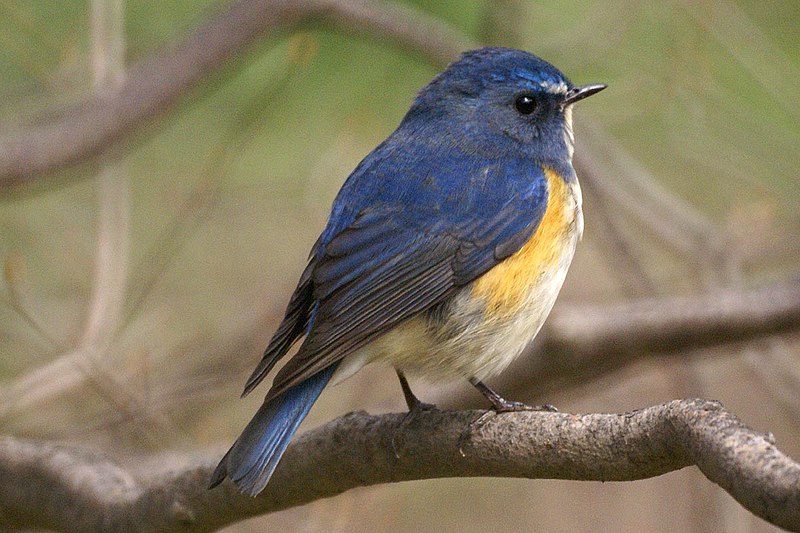
The Red-flanked bluetail, also known as the orange-flanked bush-robin, is a colorful passerine bird that belongs to the Old World flycatcher family. They are often referred to as chats.
These migratory birds are small in size and feed on insects. They breed in mixed coniferous forests with undergrowth and are known for their beautiful appearance.
Although they were once classified as a member of the thrush family, they are now more commonly recognized as a flycatcher species.
The Red-flanked bluetail can be found in parts of Europe and Asia during the breeding season, and then migrate to different locations during the winter months.
Overall, this species is admired for its striking colors and unique characteristics.
Scientific classification:
| Kingdom | Animalia |
| Phylum | Chordata |
| Class | Aves |
| Order | Passeriformes |
| Family | Muscicapidae |
| Genus | Tarsiger |
| Species | T. cyanurus |
Also Featured In: Birds of Kobe,
50. Honeycreepers
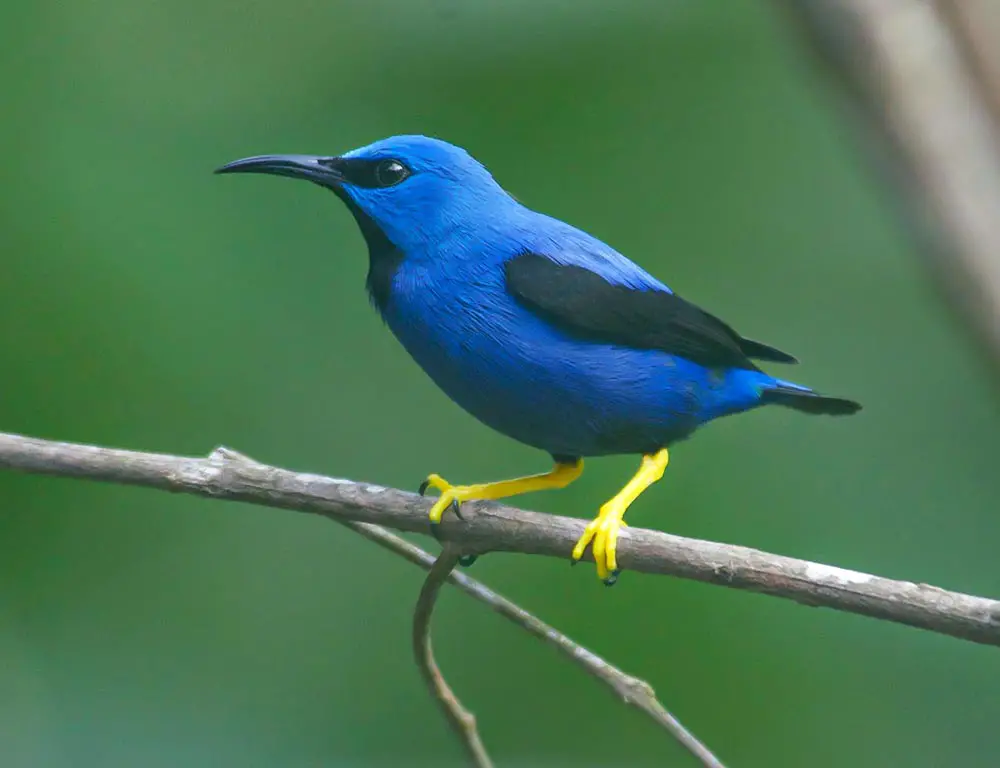
Honeycreepers are small birds found in the tropical New World from Mexico to Brazil. They have long curved bills and are specialist nectar feeders. They mainly inhabit the forest canopy and are part of the tanager family Thraupidae.
The four species of Cyanerpes have colorful legs, with males sporting glossy purple feathers. They also have long wings and a short tail.
Honeycreepers are beautiful birds that play an essential role in pollination by feeding on nectar.
Their unique bills allow them to extract the nectar from flowers, making them an important player in the ecosystem.
These birds are a delight to observe, with their vibrant colors and acrobatic movements in the treetops.
Scientific classification:
| Kingdom | Animalia |
| Phylum | Chordata |
| Class | Aves |
| Order | Passeriformes |
| Family | Thraupidae |
| Genus | Cyanerpes Oberholser, 1899 |
51. Shining Honeycreeper
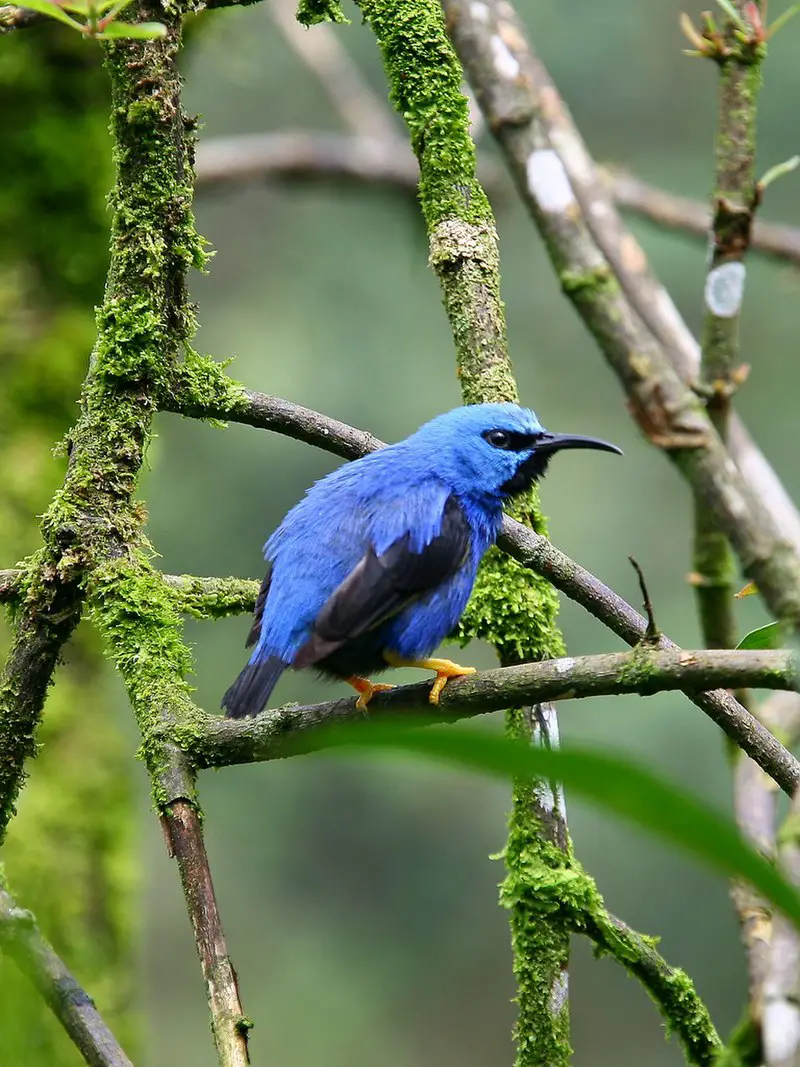
The shining honeycreeper is a petite bird belonging to the tanager family, found in the tropical New World in Central America, from southern Mexico to Panama and northwest Colombia.
It is known for its stunning iridescent plumage that shines like honey in the sunlight. Unlike its cousin, the purple honeycreeper, the two species breed in the same areas in eastern Panama and northwest Colombia.
This forest canopy species is usually found fluttering around in the treetops where it feeds on insects and nectar.
The striking male bird is easily distinguishable from the female, as the former displays bright blue feathers in contrast to the female’s greenish-yellow plumage.
With its small frame and stunning colors, the shining honeycreeper is certainly a sight to behold.Scientific classification:
| Kingdom | Animalia |
| Phylum | Chordata |
| Class | Aves |
| Order | Passeriformes |
| Family | Thraupidae |
| Genus | Cyanerpes |
| Species | C. lucidus |
To Recap
the world is teeming with a remarkable variety of bluebirds, each with its own unique characteristics and habitat preferences.
From the vibrant blue jay to the elusive mountain bluebird, these feathered creatures add color and charm to our surroundings.
Whether you’re an avid birder or simply appreciate the beauty of nature, exploring the diverse world of bluebirds is a captivating journey.
However, it’s crucial to remember that many of these species face various threats, including habitat loss and climate change.
Conservation efforts are essential to ensure that these stunning blue birds continue to grace our landscapes for generations to come.